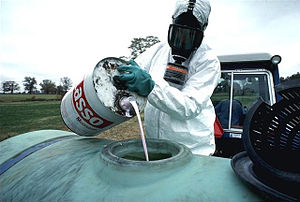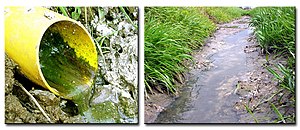農業對環境的影響:修订间差异
小 +Template:農業 |
ThomasYehYeh(留言 | 贡献) 把[Environmental impact of agriculture]全部翻譯為中文,因此而覆蓋住前輩的簡短作品,在此致歉。人類的存在,只要人口多,做法無節制,對環境的影響會非常巨大,有威脅人類生存的可能。敬請指教。 标签:HTML註解 |
||
| 第1行: | 第1行: | ||
'''農業對環境的影響'''({{lang-en|Environmental impact of agriculture}})中所談論的是由不同的耕作方式對周圍生態系統所產生的影響,以及根據影響狀況,可追溯到採用的耕作方式。.<ref>{{Cite book|last1=Frouz|first1=Jan|last2=Frouzová|first2=Jaroslava|date=2022|title=Applied Ecology|url=https://link.springer.com/book/10.1007/978-3-030-83225-4|language=en-gb|doi=10.1007/978-3-030-83225-4|isbn=978-3-030-83224-7 |s2cid=245009867 }}</ref>這類影響會因農民的做法及其規模,而有很大差異。若要減緩影響,可採用[[永續農業|可持續性農業]]的做法達到目的。農業對環境產生負面影響是個由來已久的問題,縱然有專家設計創新手段來減少破壞和提高生態效率,但仍然令人擔憂。<ref>{{Cite journal|last1=Gołaś|first1=Marlena|last2=Sulewski|first2=Piotr|last3=Wąs|first3=Adam|last4=Kłoczko-Gajewska|first4=Anna|last5=Pogodzińska|first5=Kinga|date=October 2020|title=On the Way to Sustainable Agriculture—Eco-Efficiency of Polish Commercial Farms|journal=Agriculture|language=en|volume=10|issue=10|pages=438|doi=10.3390/agriculture10100438|doi-access=free}}</ref>雖然{{le|遊牧式畜牧|pastoralism}}對環境較為有利,但現代{{le|肉類生產對環境的影響|environmental impact of meat production}}程度仍高於著重生產水果、蔬菜和其他[[生物質]]的農業活動。由牛糞中[[氨]]的排放而造成的環境污染,一直是人們關注的問題。<ref>{{Cite journal|last1=Naujokienė|first1=Vilma|last2=Bagdonienė|first2=Indrė|last3=Bleizgys|first3=Rolandas|last4=Rubežius|first4=Mantas|date=April 2021|title=A Biotreatment Effect on Dynamics of Cattle Manure Composition and Reduction of Ammonia Emissions from Agriculture|journal=Agriculture|language=en|volume=11|issue=4|pages=303|doi=10.3390/agriculture11040303|doi-access=free}}</ref> |
|||
[[File:Water pollution in the Wairarapa.JPG|right|thumb|250px|新西蘭農業活動造成農村溪水污染。]] |
|||
針對環境影響評估,專家採用的指標有兩種:根據農民的生產方式的“手段指標”,以及耕作方式對耕作系統或環境所產生排放影響的“效果指標”。手段指標的一個例子是地下水的品質,會受土壤接受[[氮]]數量的影響。而衡量[[硝酸鹽]]流失到地下水的程度則是種效果指標。<ref name="sciencedirect.com">{{cite journal|last1=van der Warf|first1=Hayo|last2=Petit|first2=Jean|title=Evaluation of the environmental impact of agriculture at the farm level: a comparison and analysis of 12 indicator- methods|journal=Agriculture, Ecosystems and Environment|date=December 2002|volume=93|issue=1–3|pages=131–145|doi=10.1016/S0167-8809(01)00354-1}}</ref>手段指標著眼於農民的做法,而效果指標則著重在農業系統實際發生的影響。例如,手段指標可用來分析農民的[[農藥]]和肥料施用的方式,而效果指標會用來分析耕作方式排放多少[[二氧化碳]]或是土壤中的氮含量有多少。<ref name="sciencedirect.com" /> |
|||
農業對環境的影響所包含的對象有:[[土壤]]、水、空氣、動物,以及土壤種類、人、植物和食物本身。農業造成大量環境退化的問題,包括有[[氣候變暖|氣候變化]]、[[森林砍伐]]、{{le|生物多樣性喪失|biodiversity loss}}、<ref name="Garnett-et-al-2013">{{cite journal | last1=Garnett | first1=T. | last2=Appleby | first2=M. C. | last3=Balmford | first3=A. | last4=Bateman | first4=I. J. | last5=Benton | first5=T. G. | last6=Bloomer | first6=P. | last7=Burlingame | first7=B. | last8=Dawkins | first8=M. | last9=Dolan | first9=L. | last10=Fraser | first10=D. | last11=Herrero | first11=M. | last12=Hoffmann | first12=Irene | author12-link=Irene Hoffmann | last13=Smith | first13=P. | last14=Thornton | first14=P. K. | last15=Toulmin | first15=C. | last16=Vermeulen | first16=S. J. | last17=Godfray | first17=H. C. J. | title=Sustainable Intensification in Agriculture: Premises and Policies | journal=[[Science (journal)|Science]] | publisher=[[American Association for the Advancement of Science]] (AAAS) | volume=341 | issue=6141 | date=2013-07-04 | issn=0036-8075 | doi=10.1126/science.1234485 | pages=33–34 | pmid=23828927 | bibcode=2013Sci...341...33G | hdl=10871/19385 | s2cid=206547513| hdl-access=free }}</ref>{{le|死區|Dead zone (ecology)}}、[[基因工程]]、{{le|灌溉對環境的影響|Environmental impact of Irrigation|灌溉問題}}、[[污染物]]、[[水土流失|土壤退化]]和廢棄物。 <ref>{{Cite journal|last1=Tilman|first1=David|last2=Balzer|first2=Christian|last3=Hill|first3=Jason|last4=Befort|first4=Belinda L.|date=2011-12-13|title=Global food demand and the sustainable intensification of agriculture|journal=Proceedings of the National Academy of Sciences|language=en|volume=108|issue=50|pages=20260–20264|doi=10.1073/pnas.1116437108|issn=0027-8424|pmc=3250154|pmid=22106295|doi-access=free}}</ref>由於農業對全球社會和環境系統甚為重要,國際社會致力提高糧食生產的[[可持續性]],這是[[聯合國]]通過的{{le|可持續發展目標2|Sustainable Development Goal 2}}中的重要目標:“終止飢餓(zero hunger)、實現[[糧食安全]]和改善[[營養]],同時促進可持續農業”。<ref>United Nations (2015) Resolution adopted by the General Assembly on 2015-09-25, [[:File:N1529189.pdf|Transforming our world: the 2030 Agenda for Sustainable Development]] ([https://www.un.org/sustainabledevelopment/sustainable-development-goals/ A/RES/70/1])</ref>[[聯合國環境署]]在其2021年“與自然和平相處”的報告中強調,農業既是驅動環境退化的因素,同時也是受到環境退化威脅的產業。<ref>United Nations Environment Programme (2021). ''Making Peace with Nature: A scientific blueprint to tackle the climate, biodiversity and pollution emergencies''. Nairobi. https://www.unep.org/resources/making-peace-nature</ref> |
|||
==不同農業生產方式== |
|||
===動物畜養=== |
|||
本節摘自肉類生產對環境的影響。 |
|||
肉類生產對環境的影響因各地採用的不同做法而有差異。所有的做法都會對環境產生多種影響,包括[[污染]]、使用[[化石燃料]]造成的{{le|溫室氣體排放|Greenhouse gas emissions}}、牲畜產生的[[甲烷]]、廢水及水和{{le|土地消耗|land consumption|土地}}的消耗。畜養牲畜以取得肉類的方式有多種,包括[[有機農業]]、{{le|自由放養|Free range}}、{{le|集約化畜牧|Intensive animal farming}}、[[自給農業]],以及小規模的[[狩獵]]和[[捕魚]]。 |
|||
{{Bar chart |
|||
| title = 畜養動物產品的營養價值及其產生的環境影響,與整體農業活動作比較<ref>Damian Carrington, [https://www.theguardian.com/environment/2018/may/31/avoiding-meat-and-dairy-is-single-biggest-way-to-reduce-your-impact-on-earth "Avoiding meat and dairy is ‘single biggest way’ to reduce your impact on Earth "], [[The Guardian]], 2018-05-31 (page visited on 2018-08-19).</ref> |
|||
| float = right |
|||
| label_type = 類別 |
|||
| data_type = 畜養動物產品的佔比 [%] |
|||
| bar_width = 20 |
|||
| width_units = em |
|||
| data_max = 100 |
|||
| label1 = [[卡路里]] |
|||
| data1 = 18 |
|||
| label2 = {{le|蛋白質|Protein (nutrient)}} |
|||
| data2 = 37 |
|||
| label3 = [[土地利用]] |
|||
| data3 = 83 |
|||
| label4 = [[溫室氣體]]排放 |
|||
| data4 = 58 |
|||
| label5 = [[水污染]] |
|||
| data5 = 57 |
|||
| label6 = [[空氣汙染]] |
|||
| data6 = 56 |
|||
| label7 = {{le|水足跡|water footprint}} |
|||
| data7 = 33 |
|||
}} |
|||
肉類生產被認為是導致當前生物多樣性喪失危機的重要因素。<ref name="ReferenceA">{{cite journal |url=https://www.science.org/content/article/meat-eaters-may-speed-worldwide-species-extinction-study-warns |title=Meat-eaters may speed worldwide species extinction, study warns |journal=Science |year=2015 |last1=Morell |first1=Virginia |doi=10.1126/science.aad1607 }}</ref><ref>{{cite journal|first1=B.|last1=Machovina|first2=K. J.|last2=Feeley|first3=W. J.|last3=Ripple|year=2015|title=Biodiversity conservation: The key is reducing meat consumption|journal=Science of the Total Environment|volume= 536|pages=419–431|doi=10.1016/j.scitotenv.2015.07.022|pmid=26231772|bibcode=2015ScTEn.536..419M}}</ref><ref name=Zalasiewicz2015>{{cite journal|first1=Mark|last1=Williams|first2=Jan|last2=Zalasiewicz|first3=P. K.|last3=Haff|first4=Christian|last4=Schwägerl|first5=Anthony D.|last5=Barnosky|first6=Erle C.|last6=Ellis|s2cid=7771527|year=2015|title=The Anthropocene Biosphere|journal=The Anthropocene Review|volume=2|issue=3|pages=196–219 |doi=10.1177/2053019615591020 }}</ref><ref>{{cite news |last= Smithers|first=Rebecca|date= 2017-10-05 |title=Vast animal-feed crops to satisfy our meat needs are destroying planet|url=https://www.theguardian.com/environment/2017/oct/05/vast-animal-feed-crops-meat-needs-destroying-planet|work= The Guardian|access-date=2017-11-03}}</ref><ref>{{cite news |last= Woodyatt |first=Amy |date=2020-05-26 |title=Human activity threatens billions of years of evolutionary history, researchers warn |url=https://www.cnn.com/2020/05/26/world/species-loss-evolution-climate-scn-intl-scli/index.html |work=[[CNN]]|access-date=2020-05-27}}</ref>[[聯合國]][[生物多樣性和生態系統服務政府間科學政策平台]](IPBES)在其2019年{{le|全球生物多樣性及生態系統評估報告|Global Assessment Report on Biodiversity and Ecosystem Services|評估報告}}中說[[工業化農業]]和[[過度捕魚|過度捕撈]]是導致物種滅絕的主要驅動因素,其中的肉類和乳製品生產佔有絕大部分。<ref>{{Cite news|url=https://www.bbc.com/news/science-environment-48169783|title=Humans 'threaten 1m species with extinction'|last=McGrath|first=Matt|date= 2019-05-06|work=[[BBC]]|access-date=2019-07-03|quote=Pushing all this forward, though, are increased demands for food from a growing global population and specifically our growing appetite for meat and fish.}}</ref><ref>{{cite news|url=https://www.theguardian.com/environment/2019/may/06/human-society-under-urgent-threat-loss-earth-natural-life-un-report|title=Human society under urgent threat from loss of Earth's natural life|last=Watts|first=Jonathan|date=2019-05-06|work=[[The Guardian]]|access-date=2019-07-03|quote=Agriculture and fishing are the primary causes of the deterioration. Food production has increased dramatically since the 1970s, which has helped feed a growing global population and generated jobs and economic growth. But this has come at a high cost. The meat industry has a particularly heavy impact. Grazing areas for cattle account for about 25% of the world’s ice-free land and more than 18% of global greenhouse gas emissions.}}</ref>[[聯合國糧食及農業組織]] (FAO) 在2006年發布名為《[[畜牧業的巨大陰影]]》的報告中說,“畜牧業是許多生態系統以及整個地球的主要壓力源。是最大的壓力源之一。是產生溫室氣體和生物多樣性喪失的重要原因,無論在[[已開發國家]]或是[[開發中國家]]中,也是造成水污染的主要來源。”<ref name=Steinfeld2006>{{Citation |last1= Steinfeld|first1= Henning|last2= Gerber|first2= Pierre|last3= Wassenaar|first3= Tom|last4= Castel|first4= Vincent|last5= Rosales|first5= Mauricio|last6= de Haan|first6= Cees|year= 2006|title= Livestock's Long Shadow: Environmental Issues and Options|publisher= FAO|location= Rome|url=http://www.europarl.europa.eu/climatechange/doc/FAO%20report%20executive%20summary.pdf }}</ref> |
|||
== 問題 == |
|||
[[File:Los Llanos, Venezuela (12832335223).jpg|thumb|肉類生產業是導致[[委內瑞拉]]森林砍伐的驅動因素。]] |
|||
=== 氣候變化 === |
|||
[[File:Average greenhouse gas emissions associated with different food products.png|thumb|生產不同食品而發生的平均溫室氣體排放。]] |
|||
{{Main|氣候變遷}} |
|||
[[氣候變化]]和農業是相互關聯的過程,兩者都在世界範圍內進行。預計[[全球變暖]]將對影響農業的條件產生重大影響,包括[[溫度]]、[[降雨量]]和[[冰川]]徑流量。這些條件決定了[[生物圈]]為[[人類]]和家養動物生產足夠[[食物]]的承載能力。[[二氧化碳]]水平上升也將對作物產量產生有害和有利的影響。評估全球氣候變化對農業的影響可能有助於正確預測和適應農業,從而最大限度地實現農業生產。雖然氣候變化對農業生產的淨影響尚不確定,但很可能會改變個別作物的適宜種植區。對這種地理變化的調整將涉及可觀的經濟成本和社會影響。 |
|||
放牧使用的土地佔有地球上無冰陸地面積的26%,而生產飼料作物佔用大約3分之1的[[耕地]]<ref name=Steinfeld2006/>(或佔大約農地的75%)。<ref>{{cite web |title=If the world adopted a plant-based diet we would reduce global agricultural land use from 4 to 1 billion hectares |url=https://ourworldindata.org/land-use-diets |website=Our World in Data |access-date=2022-05-27}}</ref><ref>{{cite news |title=20 meat and dairy firms emit more greenhouse gas than Germany, Britain or France |url=https://www.theguardian.com/environment/2021/sep/07/20-meat-and-dairy-firms-emit-more-greenhouse-gas-than-germany-britain-or-france |access-date= 2022-05-27 |work=The Guardian |date=2021-09-07 |language=en}}</ref>全球為生產糧食所產生的溫室氣體排放,佔全球人為溫室氣體排放量的3分之1,<ref>{{cite news |title=FAO – News Article: Food systems account for more than one third of global greenhouse gas emissions |url=http://www.fao.org/news/story/en/item/1379373/icode/ |access-date= 2021-04-22 |work=www.fao.org |language=en}}</ref><ref>{{cite journal |last1=Crippa |first1=M. |last2=Solazzo |first2=E. |last3=Guizzardi |first3=D. |last4=Monforti-Ferrario |first4=F. |last5=Tubiello |first5=F. N. |last6=Leip |first6=A. |title=Food systems are responsible for a third of global anthropogenic GHG emissions |journal=Nature Food |date=March 2021 |volume=2 |issue=3 |pages=198–209 |doi=10.1038/s43016-021-00225-9 |language=en |issn=2662-1355|doi-access=free }}</ref>而其中肉類生產的佔比就接近60%。<ref name="snmeat"/><ref>{{cite journal |last1=Xu |first1=Xiaoming |last2=Sharma |first2=Prateek |last3=Shu |first3=Shijie |last4=Lin |first4=Tzu-Shun |last5=Ciais |first5=Philippe |last6=Tubiello |first6=Francesco N. |last7=Smith |first7=Pete |last8=Campbell |first8=Nelson |last9=Jain |first9=Atul K. |title=Global greenhouse gas emissions from animal-based foods are twice those of plant-based foods |journal=Nature Food |date=September 2021 |volume=2 |issue=9 |pages=724–732 |doi=10.1038/s43016-021-00358-x |hdl=2164/18207 |s2cid=240562878 |language=en |issn=2662-1355}} News article: {{cite news |title=Meat accounts for nearly 60% of all greenhouse gases from food production, study finds |url=https://www.theguardian.com/environment/2021/sep/13/meat-greenhouses-gases-food-production-study |access-date=2022-05-27 |work=The Guardian |date=2021-09-13 |language=en}}</ref> |
|||
與此同時,農業已被證明對氣候變化產生重大影響,主要是通過[[二氧化碳]]、[[甲烷]]和[[一氧化氮]]等[[溫室氣體]]。此外,實行耕作,施肥和農藥施用的農業也釋放[[氨]]、[[硝酸]]、[[磷]]和許多其他影響空氣,水和土壤質量,以及生物多樣性。農業也改變了地球的土地覆蓋,改變其吸收或反射熱量和光的能力。二氧化碳的主要人為來源是森林砍伐和沙漠化等土地利用變化以及化石燃料的使用; 農業本身是增加地球大氣中甲烷和氧化亞氮濃度的主要因素。<ref name="sciencedirect.com">{{cite journal|title=Evaluation of the environmental impact of agriculture at the farm level: a comparison and analysis of 12 indicator-based methods|url=http://www.sciencedirect.com/science/article/pii/S0167880901003541|first1=Hayo|last2=Petit|first2=Jean|date=December 2002|journal=Agriculture, Ecosystems and Environment|accessdate=21 April 2015|issue=1-3|doi=10.1016/S0167-8809(01)00354-1|volume=93|pages=131–145|last1=van der Warf|archive-date=2018-09-19|archive-url=https://web.archive.org/web/20180919122640/https://www.sciencedirect.com/science/article/pii/S0167880901003541}}</ref> |
|||
[[File:Cereals allocated to food, animal feed and fuel, World.png|thumb|世界穀類生產中,用於動物飼料的有甚大的佔比。]] |
|||
在種植供人類和動物食用的作物之間,存在對土地等資源的競爭,<ref>{{Cite journal|last1=Manceron|first1=Stéphane|last2=Ben-Ari|first2=Tamara|last3=Dumas|first3=Patrice|date=July 2014|title=Feeding proteins to livestock: Global land use and food vs. feed competition|journal=OCL|volume=21|issue=4|pages=D408|doi=10.1051/ocl/2014020|issn=2272-6977|doi-access=free}}</ref><ref name="10.1146/annurev-resource-111820-032340">{{cite journal |last1=Parlasca |first1=Martin C. |last2=Qaim |first2=Matin |title=Meat Consumption and Sustainability |journal=Annual Review of Resource Economics |date=2022-10-05 |volume=14 |doi=10.1146/annurev-resource-111820-032340 |url=https://www.annualreviews.org/doi/10.1146/annurev-resource-111820-032340 |issn=1941-1340}}</ref><ref>{{Cite journal|last1=Steinfeld|first1=H.|last2=Opio|first2=C.|date=2010|title=The availability of feeds for livestock: Competition with human consumption in present world|url=https://www.cambridge.org/core/services/aop-cambridge-core/content/view/B7D5D3D44F757822AEE2C75F01D046B7/S2040470010000488a.pdf/the-availability-of-feeds-for-livestock-competition-with-human-consumption-in-present-world.pdf|journal=Advances in Animal Biosciences|language=en|volume=1|issue=2|pages=421|doi=10.1017/S2040470010000488|doi-access=free}}</ref>其中“全球搶用土地趨勢(global land squeeze)”<ref>{{cite web |last1=Hanson |first1=Craig |last2=Ranganathan |first2=Janet |title=How to Manage the Global Land Squeeze? Produce, Protect, Reduce, Restore |url=https://www.wri.org/insights/manage-global-land-squeeze-produce-protect-reduce-restore |access-date=2022-05-27 |language=en |date= 2022-02-14}}</ref>也會影響到[[糧食安全]]。<ref>{{cite web |last1=Hanson |first1=Craig |last2=Ranganathan |first2=Janet |title=How to Manage the Global Land Squeeze? Produce, Protect, Reduce, Restore |url=https://www.wri.org/insights/manage-global-land-squeeze-produce-protect-reduce-restore |access-date=27 May 2022 |language=en |date=2022-02-14}}</ref>肉類生產,尤其是[[牛肉]]的,是導致熱帶雨林遭到砍伐的主要驅動力,<ref name="snmeat"/>其中大約80%轉化的土地是為飼養牛隻而用,<ref>{{cite news|last=Wang|first=George C.|date=2017-04-09|title=Go vegan, save the planet|work=[[CNN]]|url=http://www.cnn.com/2017/04/08/opinions/go-vegan-save-the-planet-wang/|access-date= 2019-08-25}}</ref><ref>{{cite news|last=Liotta|first=Edoardo|date=2019-08-23|title=Feeling Sad About the Amazon Fires? Stop Eating Meat|work=[[Vice Media|Vice]]|url=https://www.vice.com/en_in/article/bjwzk4/feeling-sad-about-the-amazon-fires-stop-eating-meat|access-date= 2019-08-25}}</ref>而自1970年以來,[[亞馬遜盆地]]所發生的森林砍伐,其中有91%的土地是為轉化作養牛之用。<ref name="fao">{{cite book|url=http://www.fao.org/docrep/010/a0701e/a0701e00.htm|title=Livestock's Long Shadow: Environmental Issues and Options|author1=Steinfeld, Henning|author2=Gerber, Pierre|author3=Wassenaar, T. D.|author4=Castel, Vincent|publisher=[[Food and Agriculture Organization of the United Nations]]|year=2006|isbn=978-92-5-105571-7|access-date=2008-08-19}}</ref><ref name="worldbank">{{cite book|url=http://www-wds.worldbank.org/servlet/WDSContentServer/WDSP/IB/2004/02/02/000090341_20040202130625/Rendered/PDF/277150PAPER0wbwp0no1022.pdf|title=Causes of Deforestation of the Brazilian Amazon|last=Margulis|first=Sergio|work=World Bank Working Paper No. 22|publisher=The World Bank|year=2004|isbn=0-8213-5691-7|location=Washington D.C.|page=9|access-date= 2008-09-04|archive-url=https://web.archive.org/web/20080910042549/http://www-wds.worldbank.org/servlet/WDSContentServer/WDSP/IB/2004/02/02/000090341_20040202130625/Rendered/PDF/277150PAPER0wbwp0no1022.pdf|archive-date=2008-09-10|url-status=live}}</ref> |
|||
其他對肉類生產的擔憂中包括有對健康的影響,這也通常與環境影響有關聯。<ref>{{cite journal |last1=Walker |first1=Polly |last2=Rhubart-Berg |first2=Pamela |last3=McKenzie |first3=Shawn |last4=Kelling |first4=Kristin |last5=Lawrence |first5=Robert S. |title=Public health implications of meat production and consumption |journal=Public Health Nutrition |date=June 2005 |volume=8 |issue=4 |pages=348–356 |doi=10.1079/PHN2005727 |pmid=15975179 |s2cid=59196 |language=en |issn=1475-2727}}</ref><ref>{{cite journal |last1=Hafez |first1=Hafez M. |last2=Attia |first2=Youssef A. |title=Challenges to the Poultry Industry: Current Perspectives and Strategic Future After the COVID-19 Outbreak |journal=Frontiers in Veterinary Science |date=2020 |volume=7 |page=516 |doi=10.3389/fvets.2020.00516 |pmid=33005639 |pmc=7479178 |issn=2297-1769|doi-access=free }}</ref><ref>{{cite journal |last1=Greger |first1=Michael |title=Primary Pandemic Prevention |journal=American Journal of Lifestyle Medicine |date=September 2021 |volume=15 |issue=5 |pages=498–505 |doi=10.1177/15598276211008134 |pmid=34646097 |pmc=8504329 |s2cid=235503730 |language=en |issn=1559-8276}}</ref><ref>{{cite journal |last1=Mehdi |first1=Youcef |last2=Létourneau-Montminy |first2=Marie-Pierre |last3=Gaucher |first3=Marie-Lou |last4=Chorfi |first4=Younes |last5=Suresh |first5=Gayatri |last6=Rouissi |first6=Tarek |last7=Brar |first7=Satinder Kaur |last8=Côté |first8=Caroline |last9=Ramirez |first9=Antonio Avalos |last10=Godbout |first10=Stéphane |title=Use of antibiotics in broiler production: Global impacts and alternatives |journal=Animal Nutrition |date= 2018-06-01 |volume=4 |issue=2 |pages=170–178 |doi=10.1016/j.aninu.2018.03.002 |pmid=30140756 |pmc=6103476 |language=en |issn=2405-6545}}</ref> |
|||
所產生的影響中有部分可歸因於畜牧業的非肉類生產部分,例如生產羊毛、蛋類和乳製品,以及用於[[耕作]]用的牲畜。據估計,世界上多達一半的農田是使用獸力來耕作。<ref>Bradford, E. (Task Force Chair). 1999. Animal agriculture and global food supply. Task Force Report No. 135. Council for Agricultural Science and Technology. 92 pp.</ref> |
|||
根據多項研究,肉類消費的增加與目前{{le|人口增長|population growth}}和個人收入(或[[國內生產總額]](GDP))的增加有關聯。如果增加趨勢維持不變,就會增加碳排放,並進一步加劇生物多樣性喪失的程度。<ref name="10.1146/annurev-resource-111820-032340"/><ref>{{cite news |last= Devlin|first=Hannah |date=2018-07-19 |title=Rising global meat consumption 'will devastate environment'|url=https://www.theguardian.com/environment/2018/jul/19/rising-global-meat-consumption-will-devastate-environment|work=The Guardian |access-date= 2018-07-21 }}</ref><ref name=":00">{{cite news |last=Carrington |first=Damian|date=2018-10-10 |title=Huge reduction in meat-eating 'essential' to avoid climate breakdown|url=https://www.theguardian.com/environment/2018/oct/10/huge-reduction-in-meat-eating-essential-to-avoid-climate-breakdown|work=[[The Guardian]] |access-date=2017-10-16}}</ref>聯合國[[政府間氣候變化專門委員會]](IPCC)在其2019年{{le|氣候變化及土地特別報告|Special Report on Climate Change and Land}}的摘要(也包含其他人的報告)<ref name="snmeat">{{cite news |title=How much does eating meat affect nations' greenhouse gas emissions? |url=https://www.sciencenews.org/article/food-emissions-data-diet-carbon-greenhouse-gas-climate-agriculture |access-date=2022-05-27 |work=Science News |date=2022-05-05}}</ref><ref name="10.1146/annurev-resource-111820-032340"/><ref name=":00"/>中斷言,世人為{{le|緩解氣候變化|Climate change mitigation|緩解}}和{{le|適應氣候變化|Climate change adaptation|適應}}氣候變化 ,需要朝[[植物性飲食]]做改變。<ref>{{cite news|url=https://www.nature.com/articles/d41586-019-02409-7|title=Eat less meat: UN climate change report calls for change to human diet|last=Schiermeier|first=Quirin|date= 2019-08-08|work=[[Nature (journal)|Nature]]|access-date=2019-08-09}}</ref> |
|||
===灌溉=== |
|||
[[File: Crop Irrigation Is Closely Tied to Groundwater Depletion Around the World.webm|thumb|地下[[含水層]]因抽取過度而會枯竭。在國際食糧貿易中,糧食生產國超用地下水是個老問題。長此以往,等含水層中的存量被用罄,就會出現糧食危機。。]] |
|||
本節摘自{{le|灌溉對環境的影響|Environmental effects of irrigation}}。 |
|||
灌溉對環境的影響與灌溉導致的土壤和水的數量和品質的變化,以及隨後對河流[[流域]]和灌溉計劃下游的自然和社會條件的影響有關聯。這些影響源於灌溉計劃的建設和運作而引起的[[水文學|水文]]條件改變。 |
|||
問題中包括有地下[[含水層]]因{{le|抽取過度|overdrafting}}而枯竭。土壤可能因{{le|灌溉均勻性|Distribution uniformity}}不良或浪費水資源和化學物,而發生過度灌溉,以及水污染。過度灌溉會導致地下水位上升的深層排水,而產生[[土壤鹽化]]問題,需要通過某種形式的地下排水來做{{le|地下水位控制|watertable control}}。但如果土壤灌溉不足,則會導致{{le|土壤鹽分控制|soil salinity control}}不佳,土壤鹽化隨之加劇,在高[[蒸發]]量地區的土壤表面會累積有毒的鹽分,變成需要利用[[淋溶作用]]把鹽分洗出,再利用[[排水]]將鹽帶走。使用含鹽或高[[鈉]]的水灌溉,會形成[[鹽鹼地]],破壞土壤結構。 |
|||
===農藥=== |
|||
{{multiple image |
|||
| align = right |
|||
| caption_align = center |
|||
| direction = vertical |
|||
| width = 300 |
|||
| image1 = Hazardous-pesticide.jpg |
|||
| caption1 = 農場工人帶著防護面罩,把劇毒農藥倒進水槽,調好後就可用於田地的噴灑。 |
|||
| image2 = Drainage nitrates vers HondeghemFr 2003 04 09.jpg |
|||
| caption2 = 田內的肥料和農藥經過[[地表逕流]]排入溪流之中。 |
|||
}} |
|||
[[File:Pesticides application 02.jpg|thumb|[[曳引機]]在剛犁過的農地上噴灑農藥,這種施藥方式容易造成{{le|農藥漂移|pesticide drift}},而最終進入水道中。|282x282px]] |
|||
本節摘自{{le|農藥對環境的影響|Environmental impact of pesticides}}。 |
|||
農藥對環境的影響,描述的是使用農藥所產生的各式後果。農藥產生的意外後果是現代工業化農業對環境造成負面影響的主要驅動因素之一。農藥是有毒化學物質,目的在殺死害蟲,但也會影響到非目標物種,包括植物、動物和人類。因為採用對整片農田噴灑或散佈的方式,農藥中有超過98%和[[除草劑]]中有超過95%會延伸到目標物種以外。<ref name="sustaining">{{cite book|author=George Tyler Miller|title=Sustaining the Earth: An Integrated Approach|url=https://archive.org/details/sustainingearthi0000mill|url-access=registration|date= 2004-01-01|publisher=Thomson/Brooks/Cole|isbn=978-0-534-40088-0 |pages=[https://archive.org/details/sustainingearthi0000mill/page/211 211]–216}}</ref>其他{{le|農用化學品|agrochemicals}},例如化學[[肥料]],也會對環境產生負面影響。 |
|||
農藥的負面影響不僅發生在其應用的地區。地表徑流和農藥漂移會把農藥帶入遙遠的水生環境或其他領域、放牧區、人類定居點和未開發地區。其他問題還有對農藥不良的生產、運輸、儲存和棄置的做法。<ref name="Tashkent">Tashkent (1998), [http://bpsp-neca.brim.ac.cn/books/actpln_uzbek/part1-3.html#Table%20E:%20Application%20rates%20of%20Pesticides%20and%20Defoliants%20(1990/1993) Part 75. Conditions and provisions for developing a national strategy for biodiversity conservation] {{webarchive|url=https://web.archive.org/web/20071013133223/http://bpsp-neca.brim.ac.cn/books/actpln_uzbek/part1-3.html |date= 2007-10-13 }}. Biodiversity Conservation National Strategy and Action Plan of Republic of Uzbekistan. Prepared by the National Biodiversity Strategy Project Steering Committee with the Financial Assistance of The Global Environmental Facility (GEF) and Technical Assistance of United Nations Development Programme (UNDP). Retrieved on 2007-09-17.</ref>長期重複使用農藥會增加害蟲的抵抗力,而其對其他物種(例如害蟲的天敵)的影響會讓害蟲問題死灰復燃。<ref name="Damalas, Christos A 2011">{{Cite journal | doi = 10.3390/ijerph8051402| title = Pesticide Exposure, Safety Issues, and Risk Assessment Indicators| journal = International Journal of Environmental Research and Public Health| volume = 8| issue = 12| pages = 1402–19| year = 2011| last1 = Damalas | first1 = C. A. | last2 = Eleftherohorinos | first2 = I. G. | pmid=21655127 | pmc=3108117| doi-access = free}}</ref>替代大量使用農藥的做法,例如{{le|綜合蟲害管理|integrated pest management}}和可持續農業技術(例如[[混養]]),可將這些後果減輕,又無須使用有害的毒性化學物質。 |
|||
根據建構環境模型顯示,全球有60%以上的農業用地(約2,450萬平方公里)“面臨至少一種以上農藥污染的風險”,超過30%處於“高風險”之中,這高風險中的3分之1位於生物多樣性高的地區。<ref>{{cite news|title=A third of global farmland at 'high' pesticide pollution risk|language=en|work=phys.org|url=https://phys.org/news/2021-03-global-farmland-high-pesticide-pollution.html|access-date= 2021-04-22}}</ref><ref>{{cite journal|last1=Tang|first1=Fiona H. M.|last2=Lenzen|first2=Manfred|last3=McBratney|first3=Alexander|last4=Maggi|first4=Federico|date=April 2021|title=Risk of pesticide pollution at the global scale|journal=Nature Geoscience|language=en|volume=14|issue=4|pages=206–210|bibcode=2021NatGe..14..206T|doi=10.1038/s41561-021-00712-5|issn=1752-0908|doi-access=free}}</ref>每種農藥或殺蟲劑都會產生特定的環境問題。由於農藥會產生不良影響,而導致許多遭到禁用,另有法規會限制和/或減少一些農藥的使用。但全球使用農藥(包括一些在某些司法管轄區已遭禁止的舊/過時殺蟲劑)的總體數量卻有增加。<ref name=s1308a>{{Cite journal | doi = 10.1126/science.1237227| title = Current Challenges and Trends in the Discovery of Agrochemicals| journal = Science| volume = 341| issue = 6147| pages = 742–6| year = 2013| last1 = Lamberth | first1 = C.| last2 = Jeanmart | first2 = S.| last3 = Luksch | first3 = T.| last4 = Plant | first4 = A. | pmid=23950530| bibcode = 2013Sci...341..742L| s2cid = 206548681}}</ref><ref>{{Cite journal|title=A survey of honey bee-collected pollen reveals widespread contamination by agricultural pesticides|year=2018|url=http://www.sciencedirect.com|doi=10.1016/j.scitotenv.2017.09.226|pmid=28968582|last1=Tosi|first1=S.|last2=Costa|first2=C.|last3=Vesco|first3=U.|last4=Quaglia|first4=G.|last5=Guido|first5=G.|journal=The Science of the Total Environment|volume=615|pages=208–218|s2cid=19956612 }}</ref> |
|||
===塑料=== |
|||
[[File:Plasticulture.jpg|thumb|300px|[種植[[草莓]]時用於覆蓋表土的塑膠[[地膜]]。]] |
|||
本節摘自{{le|農業塑料栽種|Plasticulture}}。 |
|||
農業塑料栽種是指在農業應用中使用[[塑料]]的做法。這類塑料被廣泛地稱為“ag applications”。 包括有土壤{{le|熏蒸|fumigation}}膜、灌溉滴灌軟管/管材、塑料植物包裝繩、育苗[[花盆|盆]]和打包材料,但這個名詞最常用於各種塑料植物/土壤覆蓋物。覆蓋物的範圍包括塑料[[地膜]]、田中行作物覆蓋物、{{le|浪型隧道|polytunnel}}以及塑料[[溫室]]等等。 |
|||
預計到2019年,用於農業的塑料將達到670萬噸,佔全球產量的2%。<ref name=":01">{{cite web|title=Why food's plastic problem is bigger than we realise|url=https://www.bbc.com/future/bespoke/follow-the-food/why-foods-plastic-problem-is-bigger-than-we-realise.html|access-date=2021-03-27|website=www.bbc.com|language=en}}</ref>農業中使用的塑料因受農業化學品的污染而難以回收。<ref name=":01" />此外,塑料降解成[[微塑料]]也對{{le|土壤健康|soil health}}、微生物本身及有益的生物(如[[蚯蚓]])有害。<ref name=":01" /><ref>{{Cite book|last=Nex|first=Sally |title=How to garden the low carbon way: the steps you can take to help combat climate change |date=2021 |isbn=978-0-7440-2928-4 |edition=First American |location=New York |oclc=1241100709}}</ref>當前的科學尚無法證實這種方式對種出的食物,或是吃了這種食物的人類是否有害。<ref name=":01" />一些政府,如[[歐洲聯盟|歐盟]]推動的[[循環經濟]],已開始對農業塑料栽種的使用和農場產生的[[塑膠污染]]予以規範。 |
|||
==各式環境問題== |
|||
農業也改變了地球(土地覆蓋),它可以改變其吸收或反射熱和光的能力,從而有助於[[輻射驅動力]]。土地利用變化,如[[森林砍伐]]和[[荒漠化]]以及[[化石燃料]]的使用是二氧化碳的主要人為來源,農業本身就是 這是增加地球[[大氣]]中甲烷和氧化亞氮濃度的主要原因。<ref>{{cite web |url=http://www.ipcc.ch/SPM2feb07.pdf |title=UN Report on Climate Change |accessdate=25 June 2007 |archiveurl=https://web.archive.org/web/20071114144734/http://www.ipcc.ch/SPM2feb07.pdf |archivedate=2007-11-14}}</ref> |
|||
{{模板:外部圖片連結/農業對環境的影響}} |
|||
=== |
===氣候變化=== |
||
{{main|{{le|農業溫室氣體排放|Greenhouse gas emissions from agriculture}}|{{le|氣候變化對農業的影響|Effects of climate change on agriculture}}}} |
|||
{{Main|森林砍伐}} |
|||
森林砍伐正在全球範圍內大規模地清除地球上的森林,造成很多土地損失。森林砍伐的原因之一是清理土地上的牧場或作物。<ref>{{cite web|url=http://news.mongabay.com/2008/0515-hance_myers.html |archive-url=https://archive.is/20120529015553/http://news.mongabay.com/2008/0515-hance_myers.html |dead-url=yes |archive-date=May 29, 2012 |title=Tropical deforestation is 'one of the worst crises since we came out of our caves' |first=Jeremy |last=Hance |work=Mongabay.com / A Place Out of Time: Tropical Rainforests and the Perils They Face |date=May 15, 2008 }}</ref> |
|||
氣候變化和農業兩項有相互關聯的作用,發生的規模為全球性。預計全球變暖會對農業的條件產生重大影響,其中包括[[溫度|氣溫]]、[[降水]]和冰河徑流。這些條件決定生物圈能否生產足夠食物,以餵養人類和畜牧動物。不斷上升的二氧化碳水準也會對作物產量產生不利和有利的影響。評估全球氣候變化對農業的影響,有助於正確預測和調整農業活動,在最大限度內提高產量。雖說氣候變化對農業生產的淨影響尚不確定,但它很可能會改變個別作物的適宜種植區。而適應這種地理轉移會涉及相當大的經濟成本和社會影響。 |
|||
森林砍伐導致數百萬物種的棲息地喪失,也是氣候變化的驅動因素。樹木就像一個碳倉庫,就是說,它們從大氣中吸收二氧化碳一種不受歡迎的溫室氣體。去除樹木會向大氣中釋放二氧化碳,留下更少的樹木來吸收空氣中二氧化碳的增加。這樣,砍伐森林加劇了氣候變化。當樹木從森林中移走時,土壤會因為不再有陰影而趨於乾燥,並且沒有足夠的樹木通過將水蒸氣返回到環境來輔助[[水循環]]。沒有樹,曾經是森林的景觀可能成為貧瘠的沙漠。砍伐樹木也會引起極端的溫度波動。<ref>{{cite web|title=Deforestation|url=http://environment.nationalgeographic.com/environment/global-warming/deforestation-overview/|website=National Geographic|accessdate=24 April 2015|archive-date=2017-01-05|archive-url=https://web.archive.org/web/20170105054755/http://environment.nationalgeographic.com/environment/global-warming/deforestation-overview/|dead-url=no}}</ref> |
|||
與此同時,農業已被證明會對氣候變化產生重大影響,主要是透過產生和釋放二氧化碳、甲烷和[[一氧化二氮]]等溫室氣體。此外,進行[[耕作]]、施肥和施用農藥還會釋放氨、硝酸鹽、[[磷]]和許多其他會影響空氣、水和土壤品質以及生物多樣性的農藥。<ref name="sciencedirect.com"/>農業還會改變地球的{{le|土地表層|land cover}},而改變其吸收或反射熱和光的能力,造成[[輻射強迫]]。土地因為森林砍伐和[[沙漠化]]]等變化,以及使用化石燃料是主要人為二氧化碳的來源;農業本身是增加大氣中甲烷和一氧化二氮濃度的主要因素。 <ref>{{cite web |url=http://www.ipcc.ch/SPM2feb07.pdf |title=UN Report on Climate Change |access-date= 2007-06-25 |archive-url=https://web.archive.org/web/20071114144734/http://www.ipcc.ch/SPM2feb07.pdf |archive-date=2007-11-14}}</ref> |
|||
大多數甲烷的排放來自畜養的牲畜,特別是牛([[反芻]]動物)和豬等。其他的動物如家禽和魚類也會產生,但影響小得多。<ref>[https://www.sciencedirect.com/science/journal/03016226/96/1 Livestock Farming Systems and their Environmental Impact]</ref>目前人們正開發一些解決方案來應對反芻動物的排放。包括利用其糞便中的[[生物燃氣]]、<ref>{{cite journal |last1=Monteny |first1=Gert-Jan |last2=Bannink |first2=Andre |last3=Chadwick |first3=David |title=Greenhouse Gas Abatement Strategies for Animal Husbandry, Agriculture, Ecosystems & Environment |journal=Agriculture, Ecosystems & Environment |year=2006 |volume=112 |issue=2–3 |pages=163–70 |doi=10.1016/j.agee.2005.08.015}}</ref>基因挑選、<ref>{{Cite web |url=https://www.genomecanada.ca/en/programs/large-scale-science/past-competitions/strategic-initiatives/bovine-genomics |title=Bovine genomics project at Genome Canada |access-date=2020-02-04 |archive-date=2019-08-10 |archive-url=https://web.archive.org/web/20190810023632/https://www.genomecanada.ca/en/programs/large-scale-science/past-competitions/strategic-initiatives/bovine-genomics |url-status=dead }}</ref><ref>[https://www.wired.com/story/canada-is-using-genetics-to-make-cows-less-gassy/ Canada is using genetics to make cows less gassy]</ref>[[免疫接種]]、驅除瘤胃原蟲及增強產乙酸菌替代{{le|產甲烷菌|Methanogen}}的作用、<ref>{{cite journal |doi=10.1071/AR99004 |title=Ruminal acetogens and their potential to lower ruminant methane emissions |journal=Australian Journal of Agricultural Research |volume=50 |issue=8 |pages=1307 |year=1999 |last1=Joblin |first1=K. N.}}</ref>提供反芻動物包含{{le|甲烷營養菌|Methanotroph}}的飼料,<ref>[https://hal.archives-ouvertes.fr/hal-01137190/document The use of direct-fed microbials for mitigation of ruminant methane emissions: a review]</ref><ref>{{cite journal |doi=10.1080/21553769.2015.1063550 |title=Exploring diet-dependent shifts in methanogen and methanotroph diversity in the rumen of Mehsani buffalo by a metagenomics approach |journal=Frontiers in Life Science |volume=8 |issue=4 |pages=371–378 |year=2015 |last1=Parmar |first1=N. R. |last2=Nirmal Kumar |first2=J. I. |last3=Joshi |first3=C. G. |s2cid=89217740 }}</ref>和修改飼料配方以及採用放牧的方式等。<ref>[https://hal.archives-ouvertes.fr/hal-01137190/document The use of direct-fed microbials for mitigation of ruminant methane emissions: a review]</ref><ref>{{cite journal |doi=10.1080/21553769.2015.1063550 |title=Exploring diet-dependent shifts in methanogen and methanotroph diversity in the rumen of Mehsani buffalo by a metagenomics approach |journal=Frontiers in Life Science |volume=8 |issue=4 |pages=371–378 |year=2015 |last1=Parmar |first1=N. R. |last2=Nirmal Kumar |first2=J. I. |last3=Joshi |first3=C. G. |s2cid=89217740 }}</ref>某些飲食配方變動(例如加入[[紫杉狀海門冬]])可減少反芻動物溫室氣體排放達99%的程度。<ref>{{cite journal | last1=Boadi | first1=D. | year=2004 | title=Mitigation strategies to reduce enteric methane emissions from dairy cows: Update review | journal=Can. J. Anim. Sci. | volume=84 | issue=3 | pages=319–335 | doi=10.4141/a03-109 | doi-access=free }}</ref><ref>Martin, C. et al. 2010. Methane mitigation in ruminants: from microbe to the farm scale. ''Animal'' 4 : pp 351-365.</ref><ref>{{cite journal | last1=Eckard | first1=R. J. | display-authors=etal | year=2010 | title=Options for the abatement of methane and nitrous oxide from ruminant production: A review | journal=Livestock Science | volume=130 | issue=1–3 | pages=47–56 | doi=10.1016/j.livsci.2010.02.010}}</ref>由於前述的負面影響,以及農業[[效率]]的原因(參見{{le|食物與飼料間之爭|Food vs. feed}}),有項預測提起到2030年,某些國家中至少某些牲畜(即牛)的數量會大幅下降。<ref>[https://www.rethinkx.com/food-and-agriculture Rethink X: food and agriculture]</ref><ref>[https://www.rethinkx.com/food-and-agriculture#food-and-agriculture-download Rethinking agriculture report]</ref> |
|||
===森林砍伐=== |
|||
{{main|森林砍伐}} |
|||
森林砍伐說的是正在全球各地發生的大規模清除森林活動,持續造成許多土地受到破壞。毀林的原因之一是開墾土地做牧場或農地用途。根據英國環保主義者{{le|諾曼·邁爾斯|Norman Myers}}的說法,這些森林砍伐中,5%是為養牛,19%是過度[[伐木]],22%是為[[油棕]]種植園,還有54%是為[[刀耕火種]]的目的。<ref>{{cite web|url=http://news.mongabay.com/2008/0515-hance_myers.html |archive-url=https://archive.today/20120529015553/http://news.mongabay.com/2008/0515-hance_myers.html |url-status=dead |archive-date= 2012-05-29 |title=Tropical deforestation is 'one of the worst crises since we came out of our caves' |first=Jeremy |last=Hance |work=Mongabay.com / A Place Out of Time: Tropical Rainforests and the Perils They Face |date=2008-05-15 }}</ref> |
|||
森林砍伐不只導致數百萬物種失去[[棲息地]],也是氣候變化的驅動因素。樹木有[[碳匯]]的功能:它們能從大氣中吸收二氧化碳。砍伐樹木會讓二氧化碳釋放進入大氣,而留下的少數樹木勢必無法吸收越來越多的二氧化碳。森林砍伐因此會加劇氣候變化。當樹木從森林中去除後,不再提供遮蔭,土壤因此會變乾,並且沒足夠的樹木把水蒸氣送返環境,無法幫助[[水循環]]。失去樹木的森林景觀有可能會變成貧瘠的沙漠。樹根也有助於固定土壤,一旦被移除後,增加發生[[泥流|土石流]]的機會。砍伐樹木後也會導致溫度的極端波動。<ref>{{cite web|title=Deforestation|url=http://environment.nationalgeographic.com/environment/global-warming/deforestation-overview/|website=National Geographic|access-date=2015-04-24}}</ref> |
|||
FAO在2000年發表的報告說“人口動態在當地環境中的作用可從原具有決定性,而變成微不足道”,而森林砍伐是“人口壓力和停滯不前的經濟、社會和技術條件造成的結果。”<ref name=population1>{{cite web | url=http://www.fao.org/sd/WPdirect/WPan0050.htm | title=Population and deforestation | author=Alain Marcoux | date=August 2000 | work=SD Dimensions | publisher=Sustainable Development Department, Food and Agriculture Organization of the United Nations (FAO) | url-status=dead | archive-url=https://web.archive.org/web/20110628184520/http://www.fao.org/sd/WPdirect/WPan0050.htm | archive-date=2011-06-28 }}</ref> |
|||
===基因工程=== |
|||
{{see also|轉基因食品爭議}} |
|||
===污染物=== |
|||
[[Image:Water pollution in the Wairarapa.JPG|thumb|right|在[[紐西蘭]]{{le|懷拉拉帕區|Wairarapa}},由當地[[酪農業]]造成的[[水污染]](攝於2003年)。]] |
|||
本節摘自[[農業污染]]。 |
|||
聯合國糧食及農業組織(糧農組織)在2000年發現,人口動態在當地環境中的作用可能從決定性變為微不足道,而人口壓力和停滯的經濟,社會和技術條件相結合可能導致森林砍伐。<ref name=population1>{{cite web | url=http://www.fao.org/sd/WPdirect/WPan0050.htm | title=Population and deforestation | author=Alain Marcoux | date=August 2000 | work=SD Dimensions | publisher=Sustainable Development Department, Food and Agriculture Organization of the United Nations (FAO) | deadurl=yes | archiveurl=https://web.archive.org/web/20110628184520/http://www.fao.org/sd/WPdirect/WPan0050.htm | archivedate=2011-06-28 | df= }}</ref> |
|||
農業污染是指因從事[[農業]]活動而產生的{{le|生物物質|biotic material}}和{{le|非生物因子|abiotic component}}副產品,這些副產品會導致環境和周圍生態系統的[[污染]]或是退化,而對人類及其經濟利益造成傷害。污染有不同的來源,從[[點源污染]](來自單個排放點)到更分散,大片環境式的污染(稱為{{le|非點源污染|Nonpoint source pollution}}和[[空氣污染]])。一旦[[污染物]]進入環境,就會直接影響到周圍的生態系統,例如導致當地野生動物死亡或是污染到[[飲用水]],以及在農業[[地表逕流|徑流]]下游的大型[[水體]]中造成的生態死區。 |
|||
=== 灌溉 === |
|||
[[灌溉]]可能導致一些問題:<ref>ILRI, 1989, Effectiveness and Social/Environmental Impacts of Irrigation Projects: a Review. In: Annual Report 1988, International Institute for Land Reclamation and Improvement (ILRI), Wageningen, The Netherlands, pp. 18–34 . On line: [http://www.waterlog.info/pdf/irreff.pdf] {{Wayback|url=http://www.waterlog.info/pdf/irreff.pdf |date=20190711081801 }}</ref> |
|||
對於農業污染物進行管理,或是疏於管理,會對其數量和影響發生關鍵的作用。涉入的管理技術包含廣泛,從動物管理和圈養,到[[農藥]]和[[肥料]]噴灑方式等。不良管理做法包括管理不完善的動物餵養、[[過度放牧|放牧]]、[[耕作]]、施肥,以及不恰當、過度或不合時宜地施用農藥。 |
|||
農業污染物會進入湖泊、河流、濕地、河口和[[地下水]]中,嚴重影響到[[水質]]。污染物包括[[沉積物]]、[[營養]]物質、[[病原體]]、農藥、[[金屬]]和[[鹽]]。<ref>{{cite web|date=2015-02-20|title=Agricultural Nonpoint Source Fact Sheet|url=http://water.epa.gov/polwaste/nps/agriculture_facts.cfm|access-date= 2015-04-22|website=United States Environmental Protection Agency|publisher=EPA}}</ref>[[畜牧業]]會產生不成比率的巨量污染物,釋放進入環境(參見{{le|畜牧業對環境的影響|environmental impact of meat production}})。如果放牧、把動物糞便儲存於處理池中以及使用糞便當做田地的肥料,會導致糞便中的[[細菌]]和病原體會進入溪流和地下水。<ref name=":20">"Investigating the Environmental Effects of Agriculture Practices on Natural Resources". ''USGS.'' January 2007, pubs.usgs.gov/fs/2007/3001/pdf/508FS2007_3001.pdf. Accessed 2018-04-02.</ref>因為土地利用變化(例如[[砍伐森林]]來開闢油棕種植園)和畜牧業而造成的空氣污染,對氣候變化產生巨大影響(參見{{le|農業產生的溫室氣體|Greenhouse gas emissions from agriculture}}),而在聯合國所屬的[[政府間氣候變化專門委員會]]氣候變化和土地特別報告(IPCC Special Report on Climate Change and Land)中的重點就是如何解決前述的問題。<ref>{{Cite book|author=IPCC|url=https://www.ipcc.ch/site/assets/uploads/2019/11/SRCCL-Full-Report-Compiled-191128.pdf|title=IPCC Special Report on Climate Change, Desertification, Land Degradation, Sustainable Land Management, Food Security, and Greenhouse gas fluxes in Terrestrial Ecosystems|publisher=In press|year=2019|editor1-last=Shukla|editor1-first=P.R.|ref={{harvid|IPCC SRCCL|2019}} <!-- ipcc:20200204 -->|author-link=IPCC|editor2-last=Skea|editor2-first=J.|editor3-last=Calvo Buendia|editor3-first=E.|editor4-last=Masson-Delmotte|editor4-first=V.|editor5-last=Pörtner|editor5-first=H.-O.|editor6-last=C. Roberts|editor6-first=D.|editor7-last=Zhai|editor7-first=P.|editor8-last=Slade|editor8-first=R.|editor9-last=Connors|editor9-first=S.|display-editors=4|editor18-first=P.|editor22-last=Malley|editor22-first=J.|editor21-last=Belkacemi|editor21-first=M.|editor20-last=Kissick|editor20-first=K.|editor19-last=Huntley|editor19-first=E.|editor18-last=Vyas|editor14-first=S.|editor17-last=Portugal Pereira|editor17-first=J.|editor16-last=Petzold|editor16-first=J.|editor15-last=Pathak|editor15-first=M.|editor14-last=Neogi|editor13-last=Luz|editor13-first=S.|editor12-last=Haughey|editor11-last=Ferrat|editor11-first=M.|editor10-last=van Diemen|editor10-first=R.|editor12-first=E.}} https://www.ipcc.ch/report/srccl/.</ref> |
|||
===土壤退化=== |
|||
其中一些問題是地下含水層通過過度採伐的耗盡。由於分配不均勻土壤可能會過度灌溉,或者灌溉計劃會浪費水,化學物質並可能導致[[水污染]]。過度灌溉可能導致地下水位升高,從而導致灌溉鹽度問題,需要通過某種形式的地下排水渠來進行防洪控制。但是,如果土壤處於灌溉狀態,土壤鹽分控制效果不佳,導致土壤鹽分增加,導致高蒸發地區土壤表面積累有毒鹽。這需要浸出去除這些鹽,並且需要一種排水來將[[鹽]]帶走。用鹽水或高鈉水灌溉可能會由於鹼性土壤的形成而破壞土壤結構。 |
|||
土壤退化指的是土壤品質的下降。導致退化的因素有多種,農業活動是其中尤為重要者。土壤中存有世上生物多樣性中的大部分,健康的土壤對於糧食生產和充足的供水極為重要。<ref>{{cite web|title=Soil Degradation|url=http://www.environment.nsw.gov.au/soildegradation/|website=Office of Environment Heritage|access-date=2015-04-23}}</ref>常見的土壤退化有鹽漬化、[[漬災]]、板結、農藥污染、土壤結構品質下降、肥沃度喪失、土壤的酸度、鹼度、鹽度的變化,以及侵蝕。土壤侵蝕是表土因水、風或農業活動的作用而流失。<ref name=":11">{{Cite web|title=Soil Erosion – Causes and Effects|url=http://www.omafra.gov.on.ca/english/engineer/facts/12-053.htm|access-date=2018-04-11|website=www.omafra.gov.on.ca|language=en-ca}}</ref>肥沃的表土對農民很有價值。 <ref name=":11" />土壤退化會影響土壤中的微生物群落,大幅影響到生物降解的能力,也會改變土壤的養分循環、病蟲害控制和化學轉化特性。<ref>{{cite web|title=Agricultural Land Use Issues|url=http://nerrs.noaa.gov/doc/siteprofile/acebasin/html/modules/landuse/lmagrlnu.htm#soil|website=National Estuarine Research Reserve System|access-date=2015-04-23|archive-url=https://web.archive.org/web/20150424054141/http://nerrs.noaa.gov/doc/siteprofile/acebasin/html/modules/landuse/lmagrlnu.htm#soil|archive-date= 2015-04-24|url-status=dead}}</ref> |
|||
=== |
====耕作侵蝕==== |
||
[[File:Eroded hilltops.jpg|left|thumb|遭耕作而發生土壤侵蝕的小丘頂。]] |
|||
合成農藥是控制農業害蟲的最普遍的方法。農藥可以通過土壤滲入並進入[[地下水污染|地下水]],以及在食品中徘徊,導致人類死亡。殺蟲劑也可以殺死非目標植物,鳥類,魚類和其他野生動物。<ref>{{cite web|title=Risks of Pesticide Use|url=http://www.epa.gov/agriculture/ag101/pestrisk.html|website=EPA|publisher=EPA|accessdate=23 April 2011|archive-date=2011-05-20|archive-url=https://web.archive.org/web/20110520010546/http://www.epa.gov/agriculture/ag101/pestrisk.html|dead-url=no}}</ref> |
|||
本節摘自{{le|耕作侵蝕|Tillage erosion}}。 |
|||
使用各種農業化學品,有些是通過使用,誤用或無知而變成污染物。農業污染對[[水質]]產生巨大影響。農業非點源(NPS)解決方案影響[[湖泊]]、[[河流]]、[[濕地]]、[[河口]]和[[地下水]]。農業非點源污染可能是由於管理不善的動物飼養作業,過度放牧,翻耕,施肥以及不正確,過度或嚴重的時間使用[[農藥]]造成的。農業污染物包括沉積物、營養物、病原體、殺蟲劑、金屬和鹽。<ref>{{cite web|title=Agricultural Nonpoint Source Fact Sheet|url=http://water.epa.gov/polwaste/nps/agriculture_facts.cfm|website=United States Environmental Protection Agency|publisher=EPA|accessdate=22 April 2015|archive-date=2015-09-07|archive-url=https://web.archive.org/web/20150907203903/http://water.epa.gov/polwaste/nps/agriculture_facts.cfm|dead-url=no}}</ref> |
|||
耕作侵蝕是耕地受耕作活動而導致的土壤侵蝕形式。<ref name=":02">{{Citation|last1=Li|first1=Sheng|title=Soil Erosion and Conservation Based in part on the article "Soil erosion and conservation" by W. S. Fyfe, which appeared in the Encyclopedia of Environmetrics .|date=2013-01-15|url=http://doi.wiley.com/10.1002/9780470057339.vas031.pub2|encyclopedia=Encyclopedia of Environmetrics|pages=vas031.pub2|editor-last=El-Shaarawi|editor-first=Abdel H.|place=Chichester, UK|publisher=John Wiley & Sons, Ltd|language=en|doi=10.1002/9780470057339.vas031.pub2|isbn=978-0-471-89997-6|access-date=2021-03-30|last2=Lobb|first2=David A.|last3=Tiessen|first3=Kevin H.D.|editor2-last=Piegorsch|editor2-first=Walter W.}}</ref><ref>{{Cite book|last=Weil|first=Ray R.|url=https://www.worldcat.org/oclc/936004363|title=The nature and properties of soils|date=2016|others=Nyle C. Brady|isbn=978-0-13-325448-8|edition=Fifteenth|location=Columbus, Ohio|pages=867–871|oclc=936004363}}</ref>有越來越多的證據顯示這種侵蝕是導致農業用地發生水土流失的主因,在世界各地,尤其是在坡地和丘陵地帶,這種侵蝕作用超過自然的水蝕和風蝕所能造成。<ref name=":12">Govers, G.; et al. (1999). “Tillage erosion and translocation: emergence of a new paradigm in soil erosion research”. Soil & Tillage Research 51:167–174.</ref><ref name=":41">Lindstrom, M.; et al. (2001). “Tillage Erosion: An Overview”. Annals of Arid Zone 40(3): 337-349.</ref><ref>{{Cite journal|last1=Van Oost|first1=K.|last2=Govers|first2=G.|last3=De Alba|first3=S.|last4=Quine|first4=T. A.|date=August 2006|title=Tillage erosion: a review of controlling factors and implications for soil quality|url=http://dx.doi.org/10.1191/0309133306pp487ra|journal=Progress in Physical Geography: Earth and Environment|volume=30|issue=4|pages=443–466|doi=10.1191/0309133306pp487ra|s2cid=55929299|issn=0309-1333}}</ref>許多描述水蝕的手冊和小冊子會顯示一種有特性的土壤侵蝕 - 遭侵蝕的小丘頂,實際上是由耕作侵蝕所引起,因為通常的水侵蝕主要是導致斜坡的中坡和下坡段的土壤流失,並非山頂部分。<ref name=":5">Van Oost, K.; et al. (2000). “Evaluating the effects of changes in landscape structure on soil erosion by water and tillage”. Landscape Ecology 15 (6):579-591.</ref><ref>{{Cite web|title=WaTEM/SEDEM Homepage|url=https://ees.kuleuven.be/geography/modelling/watemsedem/|url-status=live}}</ref><ref name=":02" /><ref name=":12" />耕作侵蝕會導致土壤退化,作物產量會因此顯著下降,造成農場經濟損失。<ref name=":2">{{Cite book|last=Lobb, D.A. |display-authors=etal |title=Soil Erosion. In Environmental sustainability of Canadian agriculture |date=2016 |author2=R. L. Clearwater |isbn=978-0-660-04855-0 |location=Ottawa |pages=77–89 |oclc=954271641}}</ref><ref name=":6">Thaler, E.A.; et al. (2021). “Thaler et al_The extent of soil loss across the US Corn Belt”. PNAS 118 (8) e1922375118</ref> |
|||
下面列出的是農業污染物排放可能帶來的額外和具體問題。: |
|||
[[File:Tillage erosion in field with diversion terraces.jpg|thumb|有導流溝的田地,途中白色部分顯示[[底土]]因受耕作侵蝕而露出。]] |
|||
*[[土地污染]] |
|||
*[[空氣污染]] |
|||
===廢棄物=== |
|||
*[[農藥]] |
|||
農業塑料栽種指的是用於農業活動中的塑料覆蓋物。農民使用塑料薄膜覆蓋多達50-70%的土壤,好讓他們使用[[滴灌]]系統來控制土壤養分和水分供給。這種灌溉不需用到降水,而使用農業塑料栽種的農場也會讓降水透過徑流得以迅速排除。這種灌溉方式,當使用農藥時,會讓農藥較易受地表徑流帶入濕地或{{le|潮溝|tidal creek}}之中。因此進入海洋的農藥和化學物質會導致貝類嚴重變形和死亡。<ref>{{cite journal|last1=Kidd|first1=Greg|title=Pesticides and Plastic Mulch Threaten the Health of Maryland and Virginia East Shore Waters|journal=Pesticides and You|date=1999–2000|volume=19|issue=4|pages=22–23|url=http://www.beyondpesticides.org/Pesticides%20and%20Plastic%20Mulch%20Threaten%20the%20Health%20of%20Maryland%20and%20Virginia%20Eastern%20Shore%20Waters.pdf|access-date=2015-04-23}}</ref> |
|||
*[[有機氯化合物]] |
|||
*[[生物修復]] |
|||
農業塑膠栽種除會導致徑流增加外,還有這類覆蓋物本身的廢棄物數量增加的問題。美國每年用於蔬菜、草莓和其他行作物和果園作物的塑料覆蓋物超過1.1億磅。大多數塑料最終是進入[[垃圾掩埋場]],但也有有其他處置方式,例如將覆蓋薄膜耙入土中、現場掩埋、就地存放、再利用、回收和焚燒。由於使用的塑料種類繁多以及分佈區域廣大,讓焚燒和回收工作變得複雜。塑料中還含有{{le|穩定劑|Stabilizer (chemistry)}}、[[染料]]以及[[重金屬]],而讓能夠回收的種類受到限制。人們持續在研究可經生物降解或{{le|光降解|Photodegradation}}的產品。雖然小有成果,但也有塑料降解需要為時多久的問題,因為許多可生物降解的產品需要很長時間才能達成。<ref>{{cite journal|last1=Hemphill|first1=Delbert|title=Agricultural Plastics as Solid Waste: What are the Options for Disposal?|journal=HortTechnology|date=March 1993|volume=3|issue=1|pages=70–73|doi=10.21273/HORTTECH.3.1.70|url=http://horttech.ashspublications.org/content/3/1/70.full.pdf+html|access-date=2015-04-23|doi-access=free}}</ref> |
|||
===各地不同的問題=== |
|||
農業對環境的影響會因地區,以及使用的生產方式而有差異。下列是世界不同地區的獨特環境問題。 |
|||
*英國清除原有田間[[樹籬]],以利大規模[[集約農業]]運作。 |
|||
=== 土壤退化 === |
|||
*[[土壤鹽化]],尤其是在[[澳大利亞]]。 |
|||
[[土壤退化]]是土壤質量的下降,這可能是許多因素造成的,特別是來自農業。土壤擁有世界上大部分的生物多樣性,健康的土壤對於糧食生產和充足的供水來說至關重要。<ref>{{cite web|title=Soil Degradation|url=http://www.environment.nsw.gov.au/soildegradation/|website=Office of Environment Heritage|accessdate=23 April 2015|archive-date=2017-06-28|archive-url=https://web.archive.org/web/20170628181641/http://www.environment.nsw.gov.au/soildegradation/|dead-url=no}}</ref> |
|||
*{{le|諾魯及巴納巴島磷礦開採|Phosphate mining in Banaba and Nauru|諾魯磷礦開採}} |
|||
*[[紐西蘭]]牲畜排放甲烷。(參見{{le|紐西蘭氣候變化| Climate change in New Zealand}}。 |
|||
*環保主義者認為[[墨西哥灣]]中的生態死區是因肥料中的氮移入海洋,導致當地[[藻華|藻類過度繁殖]]的結果。 |
|||
*農業貿易的耦合導致的{{le|級聯效應|cascade effect}}和{{le|外溢效益|Spillover (economics)}}。(參見{{le|環境因素|environmental factor}}#Socioeconomic drivers) |
|||
==可持續農業== |
|||
{{main|永續農業}} |
|||
可持續農業的理念是農業可為當代生產必要的東西,但不會侵犯到後代做同樣事的能力。 |
|||
近幾十年來世界人口呈指型增長,為滿足對食物的需求,必須開發更多的農地,而反過來又增加對環境的影響。全球人口仍在增加中,一些批評者懷疑,由於全球變暖導致糧食產量下降,最後人口數目會因糧食的問題而穩定下來。 |
|||
農業也會對生物多樣性產生負面影響。<ref name="Garnett-et-al-2013" />[[有機農業]]是種多面向的可持續農業方式,在小規模的情況下,對環境產生較小的影響。但在大多數情況下,有機農業的單位面積產量較低。<ref>{{cite journal|last1=Seufert|first1=Verena|last2=Ramankutty|first2=Navin|last3=Foley|first3=Jonathan A.|title=Comparing the yields of organic and conventional agriculture|journal=Nature|date=2012-04-25|volume=485|issue=7397|pages=229–232|doi=10.1038/nature11069|pmid=22535250|bibcode=2012Natur.485..229S|s2cid=2702124}}</ref>如果要廣泛採用有機農業,就需要清理更多土地,以及抽取更多水資源來達到相同的生產水準。一項在歐洲所做的[[綜合分析]]就發現通常有機農場每單位面積的[[土壤有機質]]含量較高,和養分損失(氮淋溶、一氧化二氮排放和氨排放)較低,但每產品單位的氨排放、氮淋溶和一氧化二氮排放較高。<ref>{{cite journal|last1=Tuomisto|first1=H.L.|last2=Hodge|first2=I.D.|last3=Riordan|first3=P.|last4=Macdonald|first4=D.W.|title=Does organic farming reduce environmental impacts? – A meta-analysis of European research|journal=Journal of Environmental Management|date=December 2012|volume=112|pages=309–320|doi=10.1016/j.jenvman.2012.08.018|pmid=22947228}}</ref>許多人認為傳統耕作導致的生物多樣性不如有機耕作的豐富。有機農業的物種豐富度平均會高出30%。有機系統的[[生物|生物體]]數量也平均高出50%。這些數據有些問題存在,因為有幾個結果顯示在有機農業系統中這些事情會有負面的影響。<ref>{{Cite journal|last1=Bengtsson|first1=Janne|last2=Ahnström|first2=Johan|last3=Weibull|first3=Ann-Christin|date=2005-04-01|title=The effects of organic agriculture on biodiversity and abundance: a meta-analysis|journal=Journal of Applied Ecology|language=en|volume=42|issue=2|pages=261–269|doi=10.1111/j.1365-2664.2005.01005.x|issn=1365-2664|doi-access=free}}</ref>反對有機農業的人認為,這些負面因素可歸咎有機農業系統 - 最初是小規模經營、具有環保意識,現在已像傳統農業般的工業化運作。這種生產方式會導致如上述,例如氣候變化和森林砍伐的問題。 |
|||
===再生農業=== |
|||
[[File:Rare Biodiversity of Pune.jpg|thumb|300px|right|生物多樣性。]] |
|||
本節摘自{{le|再生農業|Regenerative agriculture}}。 |
|||
再生農業是種對食糧和農業系統採取[[保育生物學|保育]]和復育的方法。它側重於[[表土]]{{le|土壤再生|soil regeneration|再生}}、增加生物多樣性、<ref>{{Cite web|url=http://www.csuchico.edu/sustainablefuture/aginitiative/description.shtml|title=Our Sustainable Future - Regenerative Ag Description|website=csuchico.edu|language=en|access-date=2017-03-09}}</ref>改善水循環、<ref>{{Cite web|url=http://regenerationinternational.org/2017/02/24/what-is-regenerative-agriculture/|title=What is Regenerative Agriculture?|last1=Underground|first1=The Carbon|last2=Initiative|first2=Regenerative Agriculture|date=2017-02-24|website=Regeneration International|access-date=2017-03-09|last3=CSU}}</ref>增強[[生態系統服務]]、支持{{le|溫室氣體隔離|Biosequestration }}、<ref>{{Cite journal|last1=Teague|first1=W. R.|last2=Apfelbaum|first2=S.|last3=Lal|first3=R.|last4=Kreuter|first4=U. P.|last5=Rowntree|first5=J.|last6=Davies|first6=C. A.|last7=Conser|first7=R.|last8=Rasmussen|first8=M.|last9=Hatfield|first9=J.|last10=Wang|first10=T.|last11=Wang|first11=F.|date=2016-03-01|title=The role of ruminants in reducing agriculture's carbon footprint in North America|journal=Journal of Soil and Water Conservation|language=en|volume=71|issue=2|pages=156–164|doi=10.2489/jswc.71.2.156|issn=0022-4561|doi-access=free}}</ref>提高對氣候變化的適應能力,以及增強農場土壤的健康和活力。 |
|||
再生農業本身並非一種特定的做法。而再生農業的支持者會採用多種可持續農業的技術。<ref name=":03">{{Cite journal|date=2020-09-01|title=Regenerative agriculture – the soil is the base|journal=Global Food Security|language=en|volume=26|pages=100404|doi=10.1016/j.gfs.2020.100404|issn=2211-9124|doi-access=free|last1=Schreefel|first1=L.|last2=Schulte|first2=R.P.O.|last3=De Boer|first3=I.J.M.|last4=Schrijver|first4=A. Pas|last5=Van Zanten|first5=H.H.E.}}</ref>做法中包括儘可能多回收農場廢棄物,並從農場外取得[[堆肥]]素材。<ref name=":1">{{Cite web|title=Regenerative Agriculture|url=http://regenerativeagriculturedefinition.com|access-date=2017-03-07|website=regenerativeagriculturedefinition.com|language=en-US}}</ref><ref name=":3">{{Cite web|title=Regenerative Agriculture|url=http://regenerativeagriculturefoundation.org/regenerative-agriculture/|url-status=live|access-date=2017-03-09|website=Regenerative Agriculture Foundation|language=en-US}}</ref><ref name=":06">{{Cite web|title=Definition — The Carbon Underground : The Carbon Underground|url=https://thecarbonunderground.org/definition/|access-date=2017-03-07|website=thecarbonunderground.org|language=en-US}}</ref><ref name=":4">{{Cite web|title=Regenerative Organic Agriculture {{!}} ORGANIC INDIA|url=https://us.organicindia.com/our-stories/regenerative-agriculture|access-date=2017-03-09|website=us.organicindia.com|language=en}}</ref>在小型農場和花園實施再生農業,通常是採用像[[樸門]]、[[生態農業]]、[[混農林業]]、{{le|復原生態學|restoration ecology}}、{{le|善用水資源設計|keyline design}}和{{le|完整農業管理|Holistic management}}等概念。大型農場不注重哲學理念,通常會使用“{{le|免耕農作|No-till farming}}”和/或“減耕”的做法。 |
|||
當土壤健康獲得改善,對投入的需求就會減少,作物產量會增加,因為土壤對[[極端天氣]]的抵抗力更強,內含的害蟲和病原體更少。<ref>{{Cite web|last=Moebius-Clune|first=B. N.|date=2016|title=Comprehensive Assessment of Soil Health – The Cornell Framework (Version 3.2)|url=https://soilhealth.cals.cornell.edu/manual/|url-status=live|access-date=2021-04-17|website=Cornell University, Cornell Soil Health Laboratory|edition=Edition 3.2}}</ref> |
|||
大多數緩解氣候變化的做法都側重於“減少溫室氣體排放”。再生農業,即透過種植可把二氧化碳轉移到土壤中的植物(透過種植和培育森林和多年生草場和草原)來捕獲大氣中的二氧化碳,這幾乎是目前唯一可用於吸收已經存在於大氣中的溫室氣體的技術,。<ref>{{cite article| url =https://www.nytimes.com/2018/04/18/magazine/dirt-save-earth-carbon-farming-climate-change.html| title =Can Dirt Save the Earth? | publisher =The New York Times Magazine | date = 2018-04-18|authors=Moises Velasquez-Manoff | accessdate = 2022-10-24 }}</ref> |
|||
[[File:Hoverfly January 2008-6.jpg|thumb|300px|right|忙著覓食的授粉昆蟲[[食蚜蠅]]。]] |
|||
===耕作技術=== |
|||
====保護性耕作==== |
|||
{{further information|{{le|免耕農作|No-till farming}}}} |
|||
保護性耕作是種替代耕作方法,能讓土壤和周圍生態系統更具有可持續性。<ref name=":0">{{Cite web|url=http://www.climatetechwiki.org/technology/conservation-tillage|title=Conservation tillage {{!}} ClimateTechWiki|website=www.climatetechwiki.org|language=en|access-date=2017-05-04}}</ref>做法是在耕作下一季作物之前,讓之前已被收穫過作物的殘餘留在土壤中來達到目的。保護性耕作已顯示出可將許多方面改善,例如保留土壤水分和減少侵蝕。但有些缺點,如需要更昂貴的設備,需要使用更多的農藥,而且正面效果需要很長時間才能顯現。<ref name=":0" />實施這種耕作法的障礙在於農民不願接受改變,並且會對比傳統方式更昂貴、更耗時的方法產生抗拒。 <ref>{{Cite journal|last=Holland|first=J. M.|date=2004-06-01|title=The environmental consequences of adopting conservation tillage in Europe: reviewing the evidence|journal=Agriculture, Ecosystems & Environment|volume=103|issue=1|pages=1–25|doi=10.1016/j.agee.2003.12.018}}</ref> |
|||
====生物防治==== |
|||
[[File:Syrphid.maggot3554.5.13.08cw.jpg|thumb|250px| [[食蚜蝇]]幼蟲(下) 正在吃[[蚜科|蚜蟲]](上)。這是一種天然的生物控制。]] |
|||
[[File:Cotesia9061.8.15.07.c.jpg|left|thumb|250px|一隻學名為{{le|Cotesia congregata|Cotesia congregata}}{{le|寄生蜂|parasitoid wasp}}成蟲,由附著在宿主[[煙草天蛾]]幼蟲身上的[[蛹]]繭孵出,寄生蜂是煙草天蛾的天敵。]] |
|||
本節摘自[[生物防治]]。 |
|||
生物防治是種利用其他生物來防治有害的昆蟲、[[蟎]]、[[雜草]]和[[植物病理學|植物病害]]的方法。<ref>{{cite book|author=Flint, Maria Louise |author2=Dreistadt, Steve H. |name-list-style=amp|editor=Clark, Jack K. |title=Natural Enemies Handbook: The Illustrated Guide to Biological Pest Control |publisher=University of California Press |year=1998 |isbn=978-0-520-21801-7 |url=https://books.google.com/books?id=FBJvpMqcV9UC |url-status=live |archive-url=https://web.archive.org/web/20160515072525/https://books.google.com/books?id=FBJvpMqcV9UC |archive-date=2016-05-15}}</ref>這是利用生物的[[捕食]]、[[寄生]]、[[植食性動物|植食]]或其他的自然機制,但通常還涉及人類積極管理行為。這種方法可作為{{le|綜合病蟲害管理計劃|integrated pest management }}(IPM)中的重要組成因素。 |
|||
生物防治有三種基本策略: 經典型(導入),即引入害蟲的天敵以實現防治的目的;誘導型(增強),施用大量天敵以達快速控制的目的;和接種型(保護),透過定期重建方式以維持天敵的數目而達到目的。<ref>{{Cite web |url=http://jenny.tfrec.wsu.edu/opm/displaySpecies.php?pn=-40 |title=Biological control |last=Unruh |first=Tom R. |date=1993 |website=Orchard Pest Management Online, Washington State University |access-date= 2017-11-08 |archive-url=https://web.archive.org/web/20181206205201/http://jenny.tfrec.wsu.edu/opm/displaySpecies.php?pn=-40 |archive-date=2018-12-06 |url-status=dead }}</ref> |
|||
害蟲的天敵,也稱為生物防治介質,有捕食者、[[擬寄生物]]、[[病原體]]和[[競爭 (生物學)|競爭]]者。植物病害的生物防治介質最常被比擬為拮抗劑。控制雜草的生物防治介質包括種子捕食者、[[植食性動物]]和植物病原體。 |
|||
土壤退化的常見屬性可能是鹽漬、澇漬、壓實、農藥污染,土壤結構質量下降、肥力損失、土壤酸度、鹼度、鹽度和[[侵蝕]]的變化。土壤退化也對生物降解產生巨大的影響,影響土壤微生物群落,可改變養分循環,病蟲害防治和土壤化學轉化特性。<ref>{{cite web|title=Agricultural Land Use Issues|url=http://nerrs.noaa.gov/doc/siteprofile/acebasin/html/modules/landuse/lmagrlnu.htm#soil|website=National Estuarine Research Reserve System|accessdate=23 April 2015|archive-url=https://web.archive.org/web/20150424054141/http://nerrs.noaa.gov/doc/siteprofile/acebasin/html/modules/landuse/lmagrlnu.htm#soil|archive-date=2015-04-24|dead-url=yes}}</ref> |
|||
生物防治也有對被非目標物種發生攻擊的可能,而對生物多樣性產生副作用,因此必須在徹底了解可能後果的情況之後才能引入。 |
|||
=== 廢物 === |
|||
塑料栽培是在農業中使用塑料覆蓋物。農民使用塑料薄膜覆蓋50 %至70 %的土壤,並允許他們使用滴灌系統更好地控制[土壤養分]和[[土壤濕度]]。在這個系統中不需要雨,使用塑料栽培的農場是為了鼓勵最快的雨水。使用[[殺蟲劑]]進行塑造可以使農藥在[地表徑流]中更容易地轉移到濕地或[[潮汐]]河流。塑料中農藥和化學品的流失可能會導致[[貝]]類嚴重變形和死亡,因為徑流將化學物質帶向海洋。<ref>{{cite journal|last1=Kidd|first1=Greg|title=Pesticides and Plastic Mulch Threaten the Health of Maryland and Virginia East Shore Waters|journal=Pesticides and You|date=1999–2000|volume=19|issue=4|pages=22–23|url=http://www.beyondpesticides.org/Pesticides%20and%20Plastic%20Mulch%20Threaten%20the%20Health%20of%20Maryland%20and%20Virginia%20Eastern%20Shore%20Waters.pdf|accessdate=23 April 2015|archive-date=2015-09-23|archive-url=https://web.archive.org/web/20150923184514/http://www.beyondpesticides.org/Pesticides%20and%20Plastic%20Mulch%20Threaten%20the%20Health%20of%20Maryland%20and%20Virginia%20Eastern%20Shore%20Waters.pdf|dead-url=no}}</ref> |
|||
除了由於塑化造成的徑流量增加之外,還存在塑料地膜本身的廢物量增加的問題。美國的蔬菜,草莓和其他果園和農作物每年的覆蓋面積超過1.1億磅。儘管還有其他的處理方法,比如在土壤中覆蓋覆蓋物,現場埋設,現場存放,再利用,回收利用和焚燒,但大多數塑料都會進入垃圾填埋場。由於使用的塑料種類繁多以及塑料的地理分佈,焚化和回收選項變得複雜。塑料還含有穩定劑和染料以及重金屬,限制了可回收產品的數量。不斷研究創造可生物降解或可光降解的覆蓋物。雖然在這方面取得了輕微的成功,但也存在塑料花費多少時間來降解的問題,因為許多可生物降解的產品需要很長時間才能分解。<ref>{{cite journal|last1=Hemphill|first1=Delbert|title=Agricultural Plastics as Solid Waste: What are the Options for Disposal?|journal=Hort Technology|date=March 1993|volume=3|issue=1|pages=70–73|url=http://horttech.ashspublications.org/content/3/1/70.full.pdf+html|accessdate=23 April 2015|archive-date=2019-12-10|archive-url=https://web.archive.org/web/20191210231352/http://horttech.ashspublications.org/content/3/1/70.full.pdf+html|dead-url=no}}</ref> |
|||
===問題=== |
|||
農業的環境影響可以根據地區以及正在使用的農業生產方法的類型而變化。 |
|||
下面列出了世界各地不同地區的一些具體環境問題: |
|||
* 在英國的綠籬去除。 |
|||
* 土壤鹽漬化,特別是在澳大利亞。 |
|||
* [[諾魯]]的磷礦開採。 |
|||
* 紐西蘭家畜甲烷排放量。 |
|||
== 可持續農業 == |
|||
{{Main|永續農業}} |
|||
[[可持續農業]]是這樣一種觀念,即農業應該以這樣的方式發生,即我們可以在不影響子孫後代的能力的情況下繼續生產。近幾十年來人口指數的增長,增加了農用地轉換的做法,以滿足對糧食的需求,從而增加了對環境的影響。全球人口仍在增加,最終趨於穩定,因為一些批評人士懷疑由於全球變暖導致產量下降,糧食生產能夠支撐全球人口。農業也會對生物多樣性產生負面影響。[[有機農業]]是一個多方面的[[可持續農業]]實踐,可以在較小的範圍內對環境產生較小的影響。然而,在大多數情況下,有機農業在單位面積產量方面的收益率較低。<ref>{{cite journal|last1=Seufert|first1=Verena|last2=Ramankutty|first2=Navin|last3=Foley|first3=Jonathan A.|title=Comparing the yields of organic and conventional agriculture|journal=Nature|date=25 April 2012|volume=485|issue=7397|pages=229–232|doi=10.1038/nature11069}}|date=October 2016}}</ref>因此,廣泛採用有機農業將需要更多的土地來清理和提取水資源以達到相同的生產水平。歐洲的一項薈萃分析發現,有機農場往往有較高的土壤有機質含量和較低的養分損失(氮浸出,一氧化二氮排放量和氨排放量),但每個產品單位的氨氮排放量,氮浸出量和氮氧化物排放量更高。<ref>{{cite journal|last1=Tuomisto|first1=H.L.|last2=Hodge|first2=I.D.|last3=Riordan|first3=P.|last4=Macdonald|first4=D.W.|title=Does organic farming reduce environmental impacts? – A meta-analysis of European research|journal=Journal of Environmental Management|date=December 2012|volume=112|pages=309–320|doi=10.1016/j.jenvman.2012.08.018}}</ref>許多人認為,傳統的耕作體係比有機體系造成的生物多樣性較少。[[有機農業]]比傳統農業顯示平均高出30%的物種豐富度。有機系統平均也有50%以上的生物體。這些數據有一些問題,因為在有機農業系統中有幾個結果表明這些東西有負面影響。<ref>{{Cite journal|last=Bengtsson|first=Janne|last2=Ahnström|first2=Johan|last3=Weibull|first3=Ann-Christin|date=2005-04-01|title=The effects of organic agriculture on biodiversity and abundance: a meta-analysis|url=http://onlinelibrary.wiley.com/doi/10.1111/j.1365-2664.2005.01005.x/abstract|journal=Journal of Applied Ecology|language=en|volume=42|issue=2|pages=261–269|doi=10.1111/j.1365-2664.2005.01005.x|issn=1365-2664|access-date=2017-11-17|archive-date=2017-11-07|archive-url=https://web.archive.org/web/20171107041828/http://onlinelibrary.wiley.com/doi/10.1111/j.1365-2664.2005.01005.x/abstract}}</ref>反對有機農業認為,這些消極是有機農業體系的一個問題。從小規模開始,具有環保意識的產品現在已經和傳統農業一樣產業化了。這種工業化可能導致上述問題,如氣候變化和森林砍伐。 |
|||
=== 保護耕作 === |
|||
保護性耕作是對土壤和周圍生態系統更可持續的農業替代耕作方法。<ref name=":0">{{Cite web|url=http://www.climatetechwiki.org/technology/conservation-tillage|title=Conservation tillage {{!}} ClimateTechWiki|website=www.climatetechwiki.org|language=en|access-date=2017-05-04|archive-url=https://web.archive.org/web/20170505154812/http://www.climatetechwiki.org/technology/conservation-tillage|archive-date=2017-05-05|dead-url=yes}}</ref> 這是通過在收穫下一批作物之前允許先前收穫作物的殘留物留在土壤中來完成的。保護性耕作已經證明可以改善諸如土壤水分瀦留和減少侵蝕等許多事情。一些缺點是這個過程需要更昂貴的設備,需要使用更多的殺蟲劑,並且需要很長時間才能看到積極的影響。<ref name=":0" />實行保護性耕作政策的障礙是農民不願意改變他們的方法,並且會抗議比他們習慣的傳統方法更為昂貴和費時的耕作方法。<ref>{{Cite journal|last=Holland|first=J. M.|date=2004-06-01|title=The environmental consequences of adopting conservation tillage in Europe: reviewing the evidence|url=http://www.sciencedirect.com/science/article/pii/S0167880904000593|journal=Agriculture, Ecosystems & Environment|volume=103|issue=1|pages=1–25|doi=10.1016/j.agee.2003.12.018|access-date=2017-11-17|archive-date=2012-11-01|archive-url=https://web.archive.org/web/20121101052919/http://www.sciencedirect.com/science/article/pii/S0167880904000593}}</ref> |
|||
其他具體方法包括:[[樸門]];和[[生物動力農業]],其中包含一個精神因素。 |
|||
== 相關條目 == |
|||
{{colbegin}} |
|||
*[[土地污染]] |
|||
*[[沉降]] |
|||
*[[生態農業]] |
|||
*[[環境問題]] |
|||
*[[棲息地]] |
|||
*[[畜牧業的巨大陰影]] |
|||
*[[生物防治]] |
|||
{{colend}} |
|||
== |
==參見== |
||
{{div col|colwidth=35em}} |
|||
=== 引用 === |
|||
* [[生態農業]] |
|||
{{Reflist|2}} |
|||
* [[農業污染]] |
|||
* {{le|農業水文鹽度模型|Saltmod}} (用作衡量農業活動對環境產生的影響) |
|||
* [[培植肉]](人造肉) |
|||
* {{le|肉類生產對環境的影響|Environmental impact of meat production}} |
|||
* {{le|食物倫理|Ethical eating}} |
|||
* {{le|發酵|Fermentation}} |
|||
* [[素肉]](植物肉) |
|||
* [[大豆]]#Environmental issues |
|||
* {{le|單細胞蛋白質Single cell protein}} |
|||
* [[擱淺資產]]#Agriculture and forestry |
|||
* {{le|集中型動物飼養經營|Concentrated animal feeding operations}} |
|||
* {{le|環境問題列表|List of environmental issues}} |
|||
* [[棲息地]] |
|||
* {{le|完整農業管理|Holistic management}} |
|||
* [[畜牧業的巨大陰影]] |
|||
* {{le|有機農業原則|Principles of Organic Agriculture}} |
|||
* {{le|有機農業研究所|Research Institute for Organic Agriculture}} |
|||
* {{le|無動物農業|Stock-free agriculture}} |
|||
* {{le|耕作侵蝕|Tillage erosion}} |
|||
{{div col end}} |
|||
== |
==參考文獻== |
||
{{reflist|2}} |
|||
== |
==進一步閱讀== |
||
*Miller, G. T., & Spoolman, S. (2012). Environmental science. Cengage Learning. {{ISBN|978-1-305-25716-0}} |
*Miller, G. T., & Spoolman, S. (2012). Environmental science. Cengage Learning. {{ISBN|978-1-305-25716-0}} |
||
*{{cite journal | last=Qaim | first=Matin | title=Benefits of genetically modified crops for the poor: household income, nutrition, and health | journal=New Biotechnology |
*{{cite journal | last=Qaim | first=Matin | title=Benefits of genetically modified crops for the poor: household income, nutrition, and health | journal=New Biotechnology | volume=27 | issue=5 | year=2010 | issn=1871-6784 | doi=10.1016/j.nbt.2010.07.009 | pages=552–557 |pmid=20643233}} |
||
==外部連結== |
|||
{{Commons category}} |
|||
*[http://www.holisticmanagement.org Holistic Management International] |
|||
*[http://www.choicesmagazine.org/2006-3/animal/2006-3-11.htm Environmental Issues in Animal Agriculture] – ''Choices'' magazine article |
|||
*[http://www.waterlog.info Waterlog.info] Website with free articles and software on environmental impacts of irrigated agriculture like [[Watertable control|waterlogging]] and [[Soil salinity control|salinization]] |
|||
*[http://www.extension.org/pages/Environmental_Planning_on_Livestock_and_Poultry_Operations Environmental Planning on Livestock and Poultry Operations] {{Webarchive|url=https://web.archive.org/web/20110209071751/http://www.extension.org/pages/Environmental_Planning_on_Livestock_and_Poultry_Operations |date=2011-02-09 }} describes several different planning processes that can be used on farms. It also includes links to several webcasts. Part of the [http://www.extension.org/animal+manure+management Livestock and Poultry Environmental Learning Center] {{Webarchive|url=https://web.archive.org/web/20101227124550/http://www.extension.org/animal+manure+management |date=2010-12-27 }} |
|||
{{World topic|Environmental impact of agriculture in|title=Environmental impact of agriculture|noredlinks=yes}} |
|||
== 外部連結 == |
|||
{{模板:人類對環境的影響}} |
|||
{{Commonscat|Environmental impact of agriculture}} |
|||
*[http://www.holisticmanagement.org] {{Wayback|url=http://www.holisticmanagement.org/ |date=20130419101836 }} Holistic Management International |
|||
*[http://www.choicesmagazine.org/2006-3/animal/2006-3-11.htm Environmental Issues in Animal Agriculture] {{Wayback|url=http://www.choicesmagazine.org/2006-3/animal/2006-3-11.htm |date=20210201234248 }} – ''Choices'' magazine article |
|||
*[http://www.waterlog.info] {{Wayback|url=http://www.waterlog.info/ |date=20100816225219 }} Website with free articles and software on environmental impacts of irrigated agriculture like [[Watertable control|waterlogging]] and [[Soil salinity control|salinization]] |
|||
*[https://web.archive.org/web/20110209071751/http://www.extension.org/pages/Environmental_Planning_on_Livestock_and_Poultry_Operations Environmental Planning on Livestock and Poultry Operations] describes several different planning processes that can be used on farms. It also includes links to several webcasts. Part of the [https://web.archive.org/web/20101227124550/http://www.extension.org/animal+manure+management Livestock and Poultry Environmental Learning Center] |
|||
{{Portal bar|Environment|Agriculture and agronomy}} |
|||
{{農業}} |
|||
{{人類對環境的影響}} |
|||
{{DEFAULTSORT:Environmental Issues With Agriculture}} |
|||
[[Category:农业对环境的影响| ]] |
|||
[[分類:農業對環境的影響| ]] |
|||
2023年1月25日 (三) 04:31的版本
農業對環境的影響(英語:Environmental impact of agriculture)中所談論的是由不同的耕作方式對周圍生態系統所產生的影響,以及根據影響狀況,可追溯到採用的耕作方式。.[1]這類影響會因農民的做法及其規模,而有很大差異。若要減緩影響,可採用可持續性農業的做法達到目的。農業對環境產生負面影響是個由來已久的問題,縱然有專家設計創新手段來減少破壞和提高生態效率,但仍然令人擔憂。[2]雖然遊牧式畜牧對環境較為有利,但現代肉類生產對環境的影響程度仍高於著重生產水果、蔬菜和其他生物質的農業活動。由牛糞中氨的排放而造成的環境污染,一直是人們關注的問題。[3]
針對環境影響評估,專家採用的指標有兩種:根據農民的生產方式的“手段指標”,以及耕作方式對耕作系統或環境所產生排放影響的“效果指標”。手段指標的一個例子是地下水的品質,會受土壤接受氮數量的影響。而衡量硝酸鹽流失到地下水的程度則是種效果指標。[4]手段指標著眼於農民的做法,而效果指標則著重在農業系統實際發生的影響。例如,手段指標可用來分析農民的農藥和肥料施用的方式,而效果指標會用來分析耕作方式排放多少二氧化碳或是土壤中的氮含量有多少。[4]
農業對環境的影響所包含的對象有:土壤、水、空氣、動物,以及土壤種類、人、植物和食物本身。農業造成大量環境退化的問題,包括有氣候變化、森林砍伐、生物多樣性喪失、[5]死區、基因工程、灌溉問題、污染物、土壤退化和廢棄物。 [6]由於農業對全球社會和環境系統甚為重要,國際社會致力提高糧食生產的可持續性,這是聯合國通過的可持續發展目標2中的重要目標:“終止飢餓(zero hunger)、實現糧食安全和改善營養,同時促進可持續農業”。[7]聯合國環境署在其2021年“與自然和平相處”的報告中強調,農業既是驅動環境退化的因素,同時也是受到環境退化威脅的產業。[8]
不同農業生產方式
動物畜養
本節摘自肉類生產對環境的影響。
肉類生產對環境的影響因各地採用的不同做法而有差異。所有的做法都會對環境產生多種影響,包括污染、使用化石燃料造成的溫室氣體排放、牲畜產生的甲烷、廢水及水和土地的消耗。畜養牲畜以取得肉類的方式有多種,包括有機農業、自由放養、集約化畜牧、自給農業,以及小規模的狩獵和捕魚。
| 類別 | 畜養動物產品的佔比 [%] |
|---|---|
| 卡路里 | 18
|
| 蛋白質 | 37
|
| 土地利用 | 83
|
| 溫室氣體排放 | 58
|
| 水污染 | 57
|
| 空氣汙染 | 56
|
| 水足跡 | 33
|
肉類生產被認為是導致當前生物多樣性喪失危機的重要因素。[10][11][12][13][14]聯合國生物多樣性和生態系統服務政府間科學政策平台(IPBES)在其2019年評估報告中說工業化農業和過度捕撈是導致物種滅絕的主要驅動因素,其中的肉類和乳製品生產佔有絕大部分。[15][16]聯合國糧食及農業組織 (FAO) 在2006年發布名為《畜牧業的巨大陰影》的報告中說,“畜牧業是許多生態系統以及整個地球的主要壓力源。是最大的壓力源之一。是產生溫室氣體和生物多樣性喪失的重要原因,無論在已開發國家或是開發中國家中,也是造成水污染的主要來源。”[17]
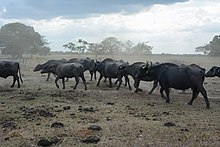

放牧使用的土地佔有地球上無冰陸地面積的26%,而生產飼料作物佔用大約3分之1的耕地[17](或佔大約農地的75%)。[18][19]全球為生產糧食所產生的溫室氣體排放,佔全球人為溫室氣體排放量的3分之1,[20][21]而其中肉類生產的佔比就接近60%。[22][23]
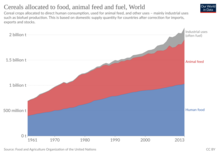
在種植供人類和動物食用的作物之間,存在對土地等資源的競爭,[24][25][26]其中“全球搶用土地趨勢(global land squeeze)”[27]也會影響到糧食安全。[28]肉類生產,尤其是牛肉的,是導致熱帶雨林遭到砍伐的主要驅動力,[22]其中大約80%轉化的土地是為飼養牛隻而用,[29][30]而自1970年以來,亞馬遜盆地所發生的森林砍伐,其中有91%的土地是為轉化作養牛之用。[31][32]
其他對肉類生產的擔憂中包括有對健康的影響,這也通常與環境影響有關聯。[33][34][35][36]
所產生的影響中有部分可歸因於畜牧業的非肉類生產部分,例如生產羊毛、蛋類和乳製品,以及用於耕作用的牲畜。據估計,世界上多達一半的農田是使用獸力來耕作。[37]
根據多項研究,肉類消費的增加與目前人口增長和個人收入(或國內生產總額(GDP))的增加有關聯。如果增加趨勢維持不變,就會增加碳排放,並進一步加劇生物多樣性喪失的程度。[25][38][39]聯合國政府間氣候變化專門委員會(IPCC)在其2019年氣候變化及土地特別報告的摘要(也包含其他人的報告)[22][25][39]中斷言,世人為緩解和適應氣候變化 ,需要朝植物性飲食做改變。[40]
灌溉
本節摘自灌溉對環境的影響。
灌溉對環境的影響與灌溉導致的土壤和水的數量和品質的變化,以及隨後對河流流域和灌溉計劃下游的自然和社會條件的影響有關聯。這些影響源於灌溉計劃的建設和運作而引起的水文條件改變。
問題中包括有地下含水層因抽取過度而枯竭。土壤可能因灌溉均勻性不良或浪費水資源和化學物,而發生過度灌溉,以及水污染。過度灌溉會導致地下水位上升的深層排水,而產生土壤鹽化問題,需要通過某種形式的地下排水來做地下水位控制。但如果土壤灌溉不足,則會導致土壤鹽分控制不佳,土壤鹽化隨之加劇,在高蒸發量地區的土壤表面會累積有毒的鹽分,變成需要利用淋溶作用把鹽分洗出,再利用排水將鹽帶走。使用含鹽或高鈉的水灌溉,會形成鹽鹼地,破壞土壤結構。
農藥

本節摘自農藥對環境的影響。
農藥對環境的影響,描述的是使用農藥所產生的各式後果。農藥產生的意外後果是現代工業化農業對環境造成負面影響的主要驅動因素之一。農藥是有毒化學物質,目的在殺死害蟲,但也會影響到非目標物種,包括植物、動物和人類。因為採用對整片農田噴灑或散佈的方式,農藥中有超過98%和除草劑中有超過95%會延伸到目標物種以外。[41]其他農用化學品,例如化學肥料,也會對環境產生負面影響。
農藥的負面影響不僅發生在其應用的地區。地表徑流和農藥漂移會把農藥帶入遙遠的水生環境或其他領域、放牧區、人類定居點和未開發地區。其他問題還有對農藥不良的生產、運輸、儲存和棄置的做法。[42]長期重複使用農藥會增加害蟲的抵抗力,而其對其他物種(例如害蟲的天敵)的影響會讓害蟲問題死灰復燃。[43]替代大量使用農藥的做法,例如綜合蟲害管理和可持續農業技術(例如混養),可將這些後果減輕,又無須使用有害的毒性化學物質。
根據建構環境模型顯示,全球有60%以上的農業用地(約2,450萬平方公里)“面臨至少一種以上農藥污染的風險”,超過30%處於“高風險”之中,這高風險中的3分之1位於生物多樣性高的地區。[44][45]每種農藥或殺蟲劑都會產生特定的環境問題。由於農藥會產生不良影響,而導致許多遭到禁用,另有法規會限制和/或減少一些農藥的使用。但全球使用農藥(包括一些在某些司法管轄區已遭禁止的舊/過時殺蟲劑)的總體數量卻有增加。[46][47]
塑料

本節摘自農業塑料栽種。
農業塑料栽種是指在農業應用中使用塑料的做法。這類塑料被廣泛地稱為“ag applications”。 包括有土壤熏蒸膜、灌溉滴灌軟管/管材、塑料植物包裝繩、育苗盆和打包材料,但這個名詞最常用於各種塑料植物/土壤覆蓋物。覆蓋物的範圍包括塑料地膜、田中行作物覆蓋物、浪型隧道以及塑料溫室等等。
預計到2019年,用於農業的塑料將達到670萬噸,佔全球產量的2%。[48]農業中使用的塑料因受農業化學品的污染而難以回收。[48]此外,塑料降解成微塑料也對土壤健康、微生物本身及有益的生物(如蚯蚓)有害。[48][49]當前的科學尚無法證實這種方式對種出的食物,或是吃了這種食物的人類是否有害。[48]一些政府,如歐盟推動的循環經濟,已開始對農業塑料栽種的使用和農場產生的塑膠污染予以規範。
各式環境問題
| 外部圖片链接 | |
|---|---|
| 農業對環境的影響 | |
氣候變化
氣候變化和農業兩項有相互關聯的作用,發生的規模為全球性。預計全球變暖會對農業的條件產生重大影響,其中包括氣溫、降水和冰河徑流。這些條件決定生物圈能否生產足夠食物,以餵養人類和畜牧動物。不斷上升的二氧化碳水準也會對作物產量產生不利和有利的影響。評估全球氣候變化對農業的影響,有助於正確預測和調整農業活動,在最大限度內提高產量。雖說氣候變化對農業生產的淨影響尚不確定,但它很可能會改變個別作物的適宜種植區。而適應這種地理轉移會涉及相當大的經濟成本和社會影響。
與此同時,農業已被證明會對氣候變化產生重大影響,主要是透過產生和釋放二氧化碳、甲烷和一氧化二氮等溫室氣體。此外,進行耕作、施肥和施用農藥還會釋放氨、硝酸鹽、磷和許多其他會影響空氣、水和土壤品質以及生物多樣性的農藥。[4]農業還會改變地球的土地表層,而改變其吸收或反射熱和光的能力,造成輻射強迫。土地因為森林砍伐和沙漠化]等變化,以及使用化石燃料是主要人為二氧化碳的來源;農業本身是增加大氣中甲烷和一氧化二氮濃度的主要因素。 [50]
大多數甲烷的排放來自畜養的牲畜,特別是牛(反芻動物)和豬等。其他的動物如家禽和魚類也會產生,但影響小得多。[51]目前人們正開發一些解決方案來應對反芻動物的排放。包括利用其糞便中的生物燃氣、[52]基因挑選、[53][54]免疫接種、驅除瘤胃原蟲及增強產乙酸菌替代產甲烷菌的作用、[55]提供反芻動物包含甲烷營養菌的飼料,[56][57]和修改飼料配方以及採用放牧的方式等。[58][59]某些飲食配方變動(例如加入紫杉狀海門冬)可減少反芻動物溫室氣體排放達99%的程度。[60][61][62]由於前述的負面影響,以及農業效率的原因(參見食物與飼料間之爭),有項預測提起到2030年,某些國家中至少某些牲畜(即牛)的數量會大幅下降。[63][64]
森林砍伐
森林砍伐說的是正在全球各地發生的大規模清除森林活動,持續造成許多土地受到破壞。毀林的原因之一是開墾土地做牧場或農地用途。根據英國環保主義者諾曼·邁爾斯的說法,這些森林砍伐中,5%是為養牛,19%是過度伐木,22%是為油棕種植園,還有54%是為刀耕火種的目的。[65]
森林砍伐不只導致數百萬物種失去棲息地,也是氣候變化的驅動因素。樹木有碳匯的功能:它們能從大氣中吸收二氧化碳。砍伐樹木會讓二氧化碳釋放進入大氣,而留下的少數樹木勢必無法吸收越來越多的二氧化碳。森林砍伐因此會加劇氣候變化。當樹木從森林中去除後,不再提供遮蔭,土壤因此會變乾,並且沒足夠的樹木把水蒸氣送返環境,無法幫助水循環。失去樹木的森林景觀有可能會變成貧瘠的沙漠。樹根也有助於固定土壤,一旦被移除後,增加發生土石流的機會。砍伐樹木後也會導致溫度的極端波動。[66]
FAO在2000年發表的報告說“人口動態在當地環境中的作用可從原具有決定性,而變成微不足道”,而森林砍伐是“人口壓力和停滯不前的經濟、社會和技術條件造成的結果。”[67]
基因工程
污染物

本節摘自農業污染。
農業污染是指因從事農業活動而產生的生物物質和非生物因子副產品,這些副產品會導致環境和周圍生態系統的污染或是退化,而對人類及其經濟利益造成傷害。污染有不同的來源,從點源污染(來自單個排放點)到更分散,大片環境式的污染(稱為非點源污染和空氣污染)。一旦污染物進入環境,就會直接影響到周圍的生態系統,例如導致當地野生動物死亡或是污染到飲用水,以及在農業徑流下游的大型水體中造成的生態死區。
對於農業污染物進行管理,或是疏於管理,會對其數量和影響發生關鍵的作用。涉入的管理技術包含廣泛,從動物管理和圈養,到農藥和肥料噴灑方式等。不良管理做法包括管理不完善的動物餵養、放牧、耕作、施肥,以及不恰當、過度或不合時宜地施用農藥。
農業污染物會進入湖泊、河流、濕地、河口和地下水中,嚴重影響到水質。污染物包括沉積物、營養物質、病原體、農藥、金屬和鹽。[68]畜牧業會產生不成比率的巨量污染物,釋放進入環境(參見畜牧業對環境的影響)。如果放牧、把動物糞便儲存於處理池中以及使用糞便當做田地的肥料,會導致糞便中的細菌和病原體會進入溪流和地下水。[69]因為土地利用變化(例如砍伐森林來開闢油棕種植園)和畜牧業而造成的空氣污染,對氣候變化產生巨大影響(參見農業產生的溫室氣體),而在聯合國所屬的政府間氣候變化專門委員會氣候變化和土地特別報告(IPCC Special Report on Climate Change and Land)中的重點就是如何解決前述的問題。[70]
土壤退化
土壤退化指的是土壤品質的下降。導致退化的因素有多種,農業活動是其中尤為重要者。土壤中存有世上生物多樣性中的大部分,健康的土壤對於糧食生產和充足的供水極為重要。[71]常見的土壤退化有鹽漬化、漬災、板結、農藥污染、土壤結構品質下降、肥沃度喪失、土壤的酸度、鹼度、鹽度的變化,以及侵蝕。土壤侵蝕是表土因水、風或農業活動的作用而流失。[72]肥沃的表土對農民很有價值。 [72]土壤退化會影響土壤中的微生物群落,大幅影響到生物降解的能力,也會改變土壤的養分循環、病蟲害控制和化學轉化特性。[73]
耕作侵蝕

本節摘自耕作侵蝕。
耕作侵蝕是耕地受耕作活動而導致的土壤侵蝕形式。[74][75]有越來越多的證據顯示這種侵蝕是導致農業用地發生水土流失的主因,在世界各地,尤其是在坡地和丘陵地帶,這種侵蝕作用超過自然的水蝕和風蝕所能造成。[76][77][78]許多描述水蝕的手冊和小冊子會顯示一種有特性的土壤侵蝕 - 遭侵蝕的小丘頂,實際上是由耕作侵蝕所引起,因為通常的水侵蝕主要是導致斜坡的中坡和下坡段的土壤流失,並非山頂部分。[79][80][74][76]耕作侵蝕會導致土壤退化,作物產量會因此顯著下降,造成農場經濟損失。[81][82]

廢棄物
農業塑料栽種指的是用於農業活動中的塑料覆蓋物。農民使用塑料薄膜覆蓋多達50-70%的土壤,好讓他們使用滴灌系統來控制土壤養分和水分供給。這種灌溉不需用到降水,而使用農業塑料栽種的農場也會讓降水透過徑流得以迅速排除。這種灌溉方式,當使用農藥時,會讓農藥較易受地表徑流帶入濕地或潮溝之中。因此進入海洋的農藥和化學物質會導致貝類嚴重變形和死亡。[83]
農業塑膠栽種除會導致徑流增加外,還有這類覆蓋物本身的廢棄物數量增加的問題。美國每年用於蔬菜、草莓和其他行作物和果園作物的塑料覆蓋物超過1.1億磅。大多數塑料最終是進入垃圾掩埋場,但也有有其他處置方式,例如將覆蓋薄膜耙入土中、現場掩埋、就地存放、再利用、回收和焚燒。由於使用的塑料種類繁多以及分佈區域廣大,讓焚燒和回收工作變得複雜。塑料中還含有穩定劑、染料以及重金屬,而讓能夠回收的種類受到限制。人們持續在研究可經生物降解或光降解的產品。雖然小有成果,但也有塑料降解需要為時多久的問題,因為許多可生物降解的產品需要很長時間才能達成。[84]
各地不同的問題
農業對環境的影響會因地區,以及使用的生產方式而有差異。下列是世界不同地區的獨特環境問題。
- 英國清除原有田間樹籬,以利大規模集約農業運作。
- 土壤鹽化,尤其是在澳大利亞。
- 諾魯磷礦開採
- 紐西蘭牲畜排放甲烷。(參見紐西蘭氣候變化。
- 環保主義者認為墨西哥灣中的生態死區是因肥料中的氮移入海洋,導致當地藻類過度繁殖的結果。
- 農業貿易的耦合導致的級聯效應和外溢效益。(參見環境因素#Socioeconomic drivers)
可持續農業
可持續農業的理念是農業可為當代生產必要的東西,但不會侵犯到後代做同樣事的能力。
近幾十年來世界人口呈指型增長,為滿足對食物的需求,必須開發更多的農地,而反過來又增加對環境的影響。全球人口仍在增加中,一些批評者懷疑,由於全球變暖導致糧食產量下降,最後人口數目會因糧食的問題而穩定下來。
農業也會對生物多樣性產生負面影響。[5]有機農業是種多面向的可持續農業方式,在小規模的情況下,對環境產生較小的影響。但在大多數情況下,有機農業的單位面積產量較低。[85]如果要廣泛採用有機農業,就需要清理更多土地,以及抽取更多水資源來達到相同的生產水準。一項在歐洲所做的綜合分析就發現通常有機農場每單位面積的土壤有機質含量較高,和養分損失(氮淋溶、一氧化二氮排放和氨排放)較低,但每產品單位的氨排放、氮淋溶和一氧化二氮排放較高。[86]許多人認為傳統耕作導致的生物多樣性不如有機耕作的豐富。有機農業的物種豐富度平均會高出30%。有機系統的生物體數量也平均高出50%。這些數據有些問題存在,因為有幾個結果顯示在有機農業系統中這些事情會有負面的影響。[87]反對有機農業的人認為,這些負面因素可歸咎有機農業系統 - 最初是小規模經營、具有環保意識,現在已像傳統農業般的工業化運作。這種生產方式會導致如上述,例如氣候變化和森林砍伐的問題。
再生農業
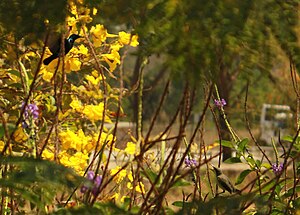
本節摘自再生農業。
再生農業是種對食糧和農業系統採取保育和復育的方法。它側重於表土再生、增加生物多樣性、[88]改善水循環、[89]增強生態系統服務、支持溫室氣體隔離、[90]提高對氣候變化的適應能力,以及增強農場土壤的健康和活力。
再生農業本身並非一種特定的做法。而再生農業的支持者會採用多種可持續農業的技術。[91]做法中包括儘可能多回收農場廢棄物,並從農場外取得堆肥素材。[92][93][94][95]在小型農場和花園實施再生農業,通常是採用像樸門、生態農業、混農林業、復原生態學、善用水資源設計和完整農業管理等概念。大型農場不注重哲學理念,通常會使用“免耕農作”和/或“減耕”的做法。
當土壤健康獲得改善,對投入的需求就會減少,作物產量會增加,因為土壤對極端天氣的抵抗力更強,內含的害蟲和病原體更少。[96]
大多數緩解氣候變化的做法都側重於“減少溫室氣體排放”。再生農業,即透過種植可把二氧化碳轉移到土壤中的植物(透過種植和培育森林和多年生草場和草原)來捕獲大氣中的二氧化碳,這幾乎是目前唯一可用於吸收已經存在於大氣中的溫室氣體的技術,。[97]
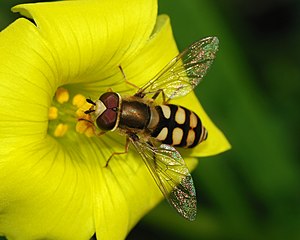
耕作技術
保護性耕作
保護性耕作是種替代耕作方法,能讓土壤和周圍生態系統更具有可持續性。[98]做法是在耕作下一季作物之前,讓之前已被收穫過作物的殘餘留在土壤中來達到目的。保護性耕作已顯示出可將許多方面改善,例如保留土壤水分和減少侵蝕。但有些缺點,如需要更昂貴的設備,需要使用更多的農藥,而且正面效果需要很長時間才能顯現。[98]實施這種耕作法的障礙在於農民不願接受改變,並且會對比傳統方式更昂貴、更耗時的方法產生抗拒。 [99]
生物防治
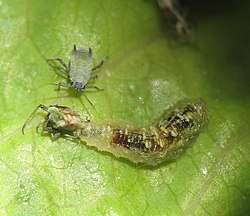
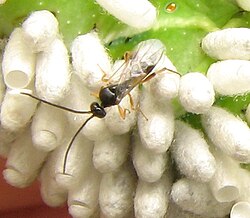
本節摘自生物防治。
生物防治是種利用其他生物來防治有害的昆蟲、蟎、雜草和植物病害的方法。[100]這是利用生物的捕食、寄生、植食或其他的自然機制,但通常還涉及人類積極管理行為。這種方法可作為綜合病蟲害管理計劃(IPM)中的重要組成因素。
生物防治有三種基本策略: 經典型(導入),即引入害蟲的天敵以實現防治的目的;誘導型(增強),施用大量天敵以達快速控制的目的;和接種型(保護),透過定期重建方式以維持天敵的數目而達到目的。[101]
害蟲的天敵,也稱為生物防治介質,有捕食者、擬寄生物、病原體和競爭者。植物病害的生物防治介質最常被比擬為拮抗劑。控制雜草的生物防治介質包括種子捕食者、植食性動物和植物病原體。
生物防治也有對被非目標物種發生攻擊的可能,而對生物多樣性產生副作用,因此必須在徹底了解可能後果的情況之後才能引入。
參見
參考文獻
- ^ Frouz, Jan; Frouzová, Jaroslava. Applied Ecology. 2022. ISBN 978-3-030-83224-7. S2CID 245009867. doi:10.1007/978-3-030-83225-4 (英国英语).
- ^ Gołaś, Marlena; Sulewski, Piotr; Wąs, Adam; Kłoczko-Gajewska, Anna; Pogodzińska, Kinga. On the Way to Sustainable Agriculture—Eco-Efficiency of Polish Commercial Farms. Agriculture. October 2020, 10 (10): 438. doi:10.3390/agriculture10100438
 (英语).
(英语).
- ^ Naujokienė, Vilma; Bagdonienė, Indrė; Bleizgys, Rolandas; Rubežius, Mantas. A Biotreatment Effect on Dynamics of Cattle Manure Composition and Reduction of Ammonia Emissions from Agriculture. Agriculture. April 2021, 11 (4): 303. doi:10.3390/agriculture11040303
 (英语).
(英语).
- ^ 4.0 4.1 4.2 van der Warf, Hayo; Petit, Jean. Evaluation of the environmental impact of agriculture at the farm level: a comparison and analysis of 12 indicator- methods. Agriculture, Ecosystems and Environment. December 2002, 93 (1–3): 131–145. doi:10.1016/S0167-8809(01)00354-1.
- ^ 5.0 5.1 Garnett, T.; Appleby, M. C.; Balmford, A.; Bateman, I. J.; Benton, T. G.; Bloomer, P.; Burlingame, B.; Dawkins, M.; Dolan, L.; Fraser, D.; Herrero, M.; Hoffmann, Irene; Smith, P.; Thornton, P. K.; Toulmin, C.; Vermeulen, S. J.; Godfray, H. C. J. Sustainable Intensification in Agriculture: Premises and Policies. Science (American Association for the Advancement of Science (AAAS)). 2013-07-04, 341 (6141): 33–34. Bibcode:2013Sci...341...33G. ISSN 0036-8075. PMID 23828927. S2CID 206547513. doi:10.1126/science.1234485. hdl:10871/19385
 .
.
- ^ Tilman, David; Balzer, Christian; Hill, Jason; Befort, Belinda L. Global food demand and the sustainable intensification of agriculture. Proceedings of the National Academy of Sciences. 2011-12-13, 108 (50): 20260–20264. ISSN 0027-8424. PMC 3250154
 . PMID 22106295. doi:10.1073/pnas.1116437108
. PMID 22106295. doi:10.1073/pnas.1116437108  (英语).
(英语).
- ^ United Nations (2015) Resolution adopted by the General Assembly on 2015-09-25, Transforming our world: the 2030 Agenda for Sustainable Development (A/RES/70/1)
- ^ United Nations Environment Programme (2021). Making Peace with Nature: A scientific blueprint to tackle the climate, biodiversity and pollution emergencies. Nairobi. https://www.unep.org/resources/making-peace-nature
- ^ Damian Carrington, "Avoiding meat and dairy is ‘single biggest way’ to reduce your impact on Earth ", The Guardian, 2018-05-31 (page visited on 2018-08-19).
- ^ Morell, Virginia. Meat-eaters may speed worldwide species extinction, study warns. Science. 2015. doi:10.1126/science.aad1607.
- ^ Machovina, B.; Feeley, K. J.; Ripple, W. J. Biodiversity conservation: The key is reducing meat consumption. Science of the Total Environment. 2015, 536: 419–431. Bibcode:2015ScTEn.536..419M. PMID 26231772. doi:10.1016/j.scitotenv.2015.07.022.
- ^ Williams, Mark; Zalasiewicz, Jan; Haff, P. K.; Schwägerl, Christian; Barnosky, Anthony D.; Ellis, Erle C. The Anthropocene Biosphere. The Anthropocene Review. 2015, 2 (3): 196–219. S2CID 7771527. doi:10.1177/2053019615591020.
- ^ Smithers, Rebecca. Vast animal-feed crops to satisfy our meat needs are destroying planet. The Guardian. 2017-10-05 [2017-11-03].
- ^ Woodyatt, Amy. Human activity threatens billions of years of evolutionary history, researchers warn. CNN. 2020-05-26 [2020-05-27].
- ^ McGrath, Matt. Humans 'threaten 1m species with extinction'. BBC. 2019-05-06 [2019-07-03].
Pushing all this forward, though, are increased demands for food from a growing global population and specifically our growing appetite for meat and fish.
- ^ Watts, Jonathan. Human society under urgent threat from loss of Earth's natural life. The Guardian. 2019-05-06 [2019-07-03].
Agriculture and fishing are the primary causes of the deterioration. Food production has increased dramatically since the 1970s, which has helped feed a growing global population and generated jobs and economic growth. But this has come at a high cost. The meat industry has a particularly heavy impact. Grazing areas for cattle account for about 25% of the world’s ice-free land and more than 18% of global greenhouse gas emissions.
- ^ 17.0 17.1 Steinfeld, Henning; Gerber, Pierre; Wassenaar, Tom; Castel, Vincent; Rosales, Mauricio; de Haan, Cees, Livestock's Long Shadow: Environmental Issues and Options (PDF), Rome: FAO, 2006
- ^ If the world adopted a plant-based diet we would reduce global agricultural land use from 4 to 1 billion hectares. Our World in Data. [2022-05-27].
- ^ 20 meat and dairy firms emit more greenhouse gas than Germany, Britain or France. The Guardian. 2021-09-07 [2022-05-27] (英语).
- ^ FAO – News Article: Food systems account for more than one third of global greenhouse gas emissions. www.fao.org. [2021-04-22] (英语).
- ^ Crippa, M.; Solazzo, E.; Guizzardi, D.; Monforti-Ferrario, F.; Tubiello, F. N.; Leip, A. Food systems are responsible for a third of global anthropogenic GHG emissions. Nature Food. March 2021, 2 (3): 198–209. ISSN 2662-1355. doi:10.1038/s43016-021-00225-9
 (英语).
(英语).
- ^ 22.0 22.1 22.2 How much does eating meat affect nations' greenhouse gas emissions?. Science News. 2022-05-05 [2022-05-27].
- ^ Xu, Xiaoming; Sharma, Prateek; Shu, Shijie; Lin, Tzu-Shun; Ciais, Philippe; Tubiello, Francesco N.; Smith, Pete; Campbell, Nelson; Jain, Atul K. Global greenhouse gas emissions from animal-based foods are twice those of plant-based foods. Nature Food. September 2021, 2 (9): 724–732. ISSN 2662-1355. S2CID 240562878. doi:10.1038/s43016-021-00358-x. hdl:2164/18207 (英语). News article: Meat accounts for nearly 60% of all greenhouse gases from food production, study finds. The Guardian. 2021-09-13 [2022-05-27] (英语).
- ^ Manceron, Stéphane; Ben-Ari, Tamara; Dumas, Patrice. Feeding proteins to livestock: Global land use and food vs. feed competition. OCL. July 2014, 21 (4): D408. ISSN 2272-6977. doi:10.1051/ocl/2014020
 .
.
- ^ 25.0 25.1 25.2 Parlasca, Martin C.; Qaim, Matin. Meat Consumption and Sustainability. Annual Review of Resource Economics. 2022-10-05, 14. ISSN 1941-1340. doi:10.1146/annurev-resource-111820-032340.
- ^ Steinfeld, H.; Opio, C. The availability of feeds for livestock: Competition with human consumption in present world (PDF). Advances in Animal Biosciences. 2010, 1 (2): 421. doi:10.1017/S2040470010000488
 (英语).
(英语).
- ^ Hanson, Craig; Ranganathan, Janet. How to Manage the Global Land Squeeze? Produce, Protect, Reduce, Restore. 2022-02-14 [2022-05-27] (英语).
- ^ Hanson, Craig; Ranganathan, Janet. How to Manage the Global Land Squeeze? Produce, Protect, Reduce, Restore. 2022-02-14 [27 May 2022] (英语).
- ^ Wang, George C. Go vegan, save the planet. CNN. 2017-04-09 [2019-08-25].
- ^ Liotta, Edoardo. Feeling Sad About the Amazon Fires? Stop Eating Meat. Vice. 2019-08-23 [2019-08-25].
- ^ Steinfeld, Henning; Gerber, Pierre; Wassenaar, T. D.; Castel, Vincent. Livestock's Long Shadow: Environmental Issues and Options. Food and Agriculture Organization of the United Nations. 2006 [2008-08-19]. ISBN 978-92-5-105571-7.
- ^ Margulis, Sergio. Causes of Deforestation of the Brazilian Amazon (PDF). World Bank Working Paper No. 22 (Washington D.C.: The World Bank). 2004: 9 [2008-09-04]. ISBN 0-8213-5691-7. (原始内容存档 (PDF)于2008-09-10).
- ^ Walker, Polly; Rhubart-Berg, Pamela; McKenzie, Shawn; Kelling, Kristin; Lawrence, Robert S. Public health implications of meat production and consumption. Public Health Nutrition. June 2005, 8 (4): 348–356. ISSN 1475-2727. PMID 15975179. S2CID 59196. doi:10.1079/PHN2005727 (英语).
- ^ Hafez, Hafez M.; Attia, Youssef A. Challenges to the Poultry Industry: Current Perspectives and Strategic Future After the COVID-19 Outbreak. Frontiers in Veterinary Science. 2020, 7: 516. ISSN 2297-1769. PMC 7479178
 . PMID 33005639. doi:10.3389/fvets.2020.00516
. PMID 33005639. doi:10.3389/fvets.2020.00516  .
.
- ^ Greger, Michael. Primary Pandemic Prevention. American Journal of Lifestyle Medicine. September 2021, 15 (5): 498–505. ISSN 1559-8276. PMC 8504329
 . PMID 34646097. S2CID 235503730. doi:10.1177/15598276211008134 (英语).
. PMID 34646097. S2CID 235503730. doi:10.1177/15598276211008134 (英语).
- ^ Mehdi, Youcef; Létourneau-Montminy, Marie-Pierre; Gaucher, Marie-Lou; Chorfi, Younes; Suresh, Gayatri; Rouissi, Tarek; Brar, Satinder Kaur; Côté, Caroline; Ramirez, Antonio Avalos; Godbout, Stéphane. Use of antibiotics in broiler production: Global impacts and alternatives. Animal Nutrition. 2018-06-01, 4 (2): 170–178. ISSN 2405-6545. PMC 6103476
 . PMID 30140756. doi:10.1016/j.aninu.2018.03.002 (英语).
. PMID 30140756. doi:10.1016/j.aninu.2018.03.002 (英语).
- ^ Bradford, E. (Task Force Chair). 1999. Animal agriculture and global food supply. Task Force Report No. 135. Council for Agricultural Science and Technology. 92 pp.
- ^ Devlin, Hannah. Rising global meat consumption 'will devastate environment'. The Guardian. 2018-07-19 [2018-07-21].
- ^ 39.0 39.1 Carrington, Damian. Huge reduction in meat-eating 'essential' to avoid climate breakdown. The Guardian. 2018-10-10 [2017-10-16].
- ^ Schiermeier, Quirin. Eat less meat: UN climate change report calls for change to human diet. Nature. 2019-08-08 [2019-08-09].
- ^ George Tyler Miller. Sustaining the Earth: An Integrated Approach
 . Thomson/Brooks/Cole. 2004-01-01: 211–216. ISBN 978-0-534-40088-0.
. Thomson/Brooks/Cole. 2004-01-01: 211–216. ISBN 978-0-534-40088-0.
- ^ Tashkent (1998), Part 75. Conditions and provisions for developing a national strategy for biodiversity conservation 互联网档案馆的存檔,存档日期2007-10-13.. Biodiversity Conservation National Strategy and Action Plan of Republic of Uzbekistan. Prepared by the National Biodiversity Strategy Project Steering Committee with the Financial Assistance of The Global Environmental Facility (GEF) and Technical Assistance of United Nations Development Programme (UNDP). Retrieved on 2007-09-17.
- ^ Damalas, C. A.; Eleftherohorinos, I. G. Pesticide Exposure, Safety Issues, and Risk Assessment Indicators. International Journal of Environmental Research and Public Health. 2011, 8 (12): 1402–19. PMC 3108117
 . PMID 21655127. doi:10.3390/ijerph8051402
. PMID 21655127. doi:10.3390/ijerph8051402  .
.
- ^ A third of global farmland at 'high' pesticide pollution risk. phys.org. [2021-04-22] (英语).
- ^ Tang, Fiona H. M.; Lenzen, Manfred; McBratney, Alexander; Maggi, Federico. Risk of pesticide pollution at the global scale. Nature Geoscience. April 2021, 14 (4): 206–210. Bibcode:2021NatGe..14..206T. ISSN 1752-0908. doi:10.1038/s41561-021-00712-5
 (英语).
(英语).
- ^ Lamberth, C.; Jeanmart, S.; Luksch, T.; Plant, A. Current Challenges and Trends in the Discovery of Agrochemicals. Science. 2013, 341 (6147): 742–6. Bibcode:2013Sci...341..742L. PMID 23950530. S2CID 206548681. doi:10.1126/science.1237227.
- ^ Tosi, S.; Costa, C.; Vesco, U.; Quaglia, G.; Guido, G. A survey of honey bee-collected pollen reveals widespread contamination by agricultural pesticides. The Science of the Total Environment. 2018, 615: 208–218. PMID 28968582. S2CID 19956612. doi:10.1016/j.scitotenv.2017.09.226.
- ^ 48.0 48.1 48.2 48.3 Why food's plastic problem is bigger than we realise. www.bbc.com. [2021-03-27] (英语).
- ^ Nex, Sally. How to garden the low carbon way: the steps you can take to help combat climate change First American. New York. 2021. ISBN 978-0-7440-2928-4. OCLC 1241100709.
- ^ UN Report on Climate Change (PDF). [2007-06-25]. (原始内容 (PDF)存档于2007-11-14).
- ^ Livestock Farming Systems and their Environmental Impact
- ^ Monteny, Gert-Jan; Bannink, Andre; Chadwick, David. Greenhouse Gas Abatement Strategies for Animal Husbandry, Agriculture, Ecosystems & Environment. Agriculture, Ecosystems & Environment. 2006, 112 (2–3): 163–70. doi:10.1016/j.agee.2005.08.015.
- ^ Bovine genomics project at Genome Canada. [2020-02-04]. (原始内容存档于2019-08-10).
- ^ Canada is using genetics to make cows less gassy
- ^ Joblin, K. N. Ruminal acetogens and their potential to lower ruminant methane emissions. Australian Journal of Agricultural Research. 1999, 50 (8): 1307. doi:10.1071/AR99004.
- ^ The use of direct-fed microbials for mitigation of ruminant methane emissions: a review
- ^ Parmar, N. R.; Nirmal Kumar, J. I.; Joshi, C. G. Exploring diet-dependent shifts in methanogen and methanotroph diversity in the rumen of Mehsani buffalo by a metagenomics approach. Frontiers in Life Science. 2015, 8 (4): 371–378. S2CID 89217740. doi:10.1080/21553769.2015.1063550.
- ^ The use of direct-fed microbials for mitigation of ruminant methane emissions: a review
- ^ Parmar, N. R.; Nirmal Kumar, J. I.; Joshi, C. G. Exploring diet-dependent shifts in methanogen and methanotroph diversity in the rumen of Mehsani buffalo by a metagenomics approach. Frontiers in Life Science. 2015, 8 (4): 371–378. S2CID 89217740. doi:10.1080/21553769.2015.1063550.
- ^ Boadi, D. Mitigation strategies to reduce enteric methane emissions from dairy cows: Update review. Can. J. Anim. Sci. 2004, 84 (3): 319–335. doi:10.4141/a03-109
 .
.
- ^ Martin, C. et al. 2010. Methane mitigation in ruminants: from microbe to the farm scale. Animal 4 : pp 351-365.
- ^ Eckard, R. J.; et al. Options for the abatement of methane and nitrous oxide from ruminant production: A review. Livestock Science. 2010, 130 (1–3): 47–56. doi:10.1016/j.livsci.2010.02.010.
- ^ Rethink X: food and agriculture
- ^ Rethinking agriculture report
- ^ Hance, Jeremy. Tropical deforestation is 'one of the worst crises since we came out of our caves'. Mongabay.com / A Place Out of Time: Tropical Rainforests and the Perils They Face. 2008-05-15. (原始内容存档于2012-05-29).
- ^ Deforestation. National Geographic. [2015-04-24].
- ^ Alain Marcoux. Population and deforestation. SD Dimensions. Sustainable Development Department, Food and Agriculture Organization of the United Nations (FAO). August 2000. (原始内容存档于2011-06-28).
- ^ Agricultural Nonpoint Source Fact Sheet. United States Environmental Protection Agency. EPA. 2015-02-20 [2015-04-22].
- ^ "Investigating the Environmental Effects of Agriculture Practices on Natural Resources". USGS. January 2007, pubs.usgs.gov/fs/2007/3001/pdf/508FS2007_3001.pdf. Accessed 2018-04-02.
- ^ IPCC. Shukla, P.R.; Skea, J.; Calvo Buendia, E.; Masson-Delmotte, V.; et al , 编. IPCC Special Report on Climate Change, Desertification, Land Degradation, Sustainable Land Management, Food Security, and Greenhouse gas fluxes in Terrestrial Ecosystems (PDF). In press. 2019. https://www.ipcc.ch/report/srccl/.
- ^ Soil Degradation. Office of Environment Heritage. [2015-04-23].
- ^ 72.0 72.1 Soil Erosion – Causes and Effects. www.omafra.gov.on.ca. [2018-04-11] (加拿大英语).
- ^ Agricultural Land Use Issues. National Estuarine Research Reserve System. [2015-04-23]. (原始内容存档于2015-04-24).
- ^ 74.0 74.1 Li, Sheng; Lobb, David A.; Tiessen, Kevin H.D., Soil Erosion and Conservation Based in part on the article "Soil erosion and conservation" by W. S. Fyfe, which appeared in the Encyclopedia of Environmetrics ., El-Shaarawi, Abdel H.; Piegorsch, Walter W. (编), Encyclopedia of Environmetrics, Chichester, UK: John Wiley & Sons, Ltd: vas031.pub2, 2013-01-15 [2021-03-30], ISBN 978-0-471-89997-6, doi:10.1002/9780470057339.vas031.pub2 (英语)
- ^ Weil, Ray R. The nature and properties of soils. Nyle C. Brady Fifteenth. Columbus, Ohio. 2016: 867–871. ISBN 978-0-13-325448-8. OCLC 936004363.
- ^ 76.0 76.1 Govers, G.; et al. (1999). “Tillage erosion and translocation: emergence of a new paradigm in soil erosion research”. Soil & Tillage Research 51:167–174.
- ^ Lindstrom, M.; et al. (2001). “Tillage Erosion: An Overview”. Annals of Arid Zone 40(3): 337-349.
- ^ Van Oost, K.; Govers, G.; De Alba, S.; Quine, T. A. Tillage erosion: a review of controlling factors and implications for soil quality. Progress in Physical Geography: Earth and Environment. August 2006, 30 (4): 443–466. ISSN 0309-1333. S2CID 55929299. doi:10.1191/0309133306pp487ra.
- ^ Van Oost, K.; et al. (2000). “Evaluating the effects of changes in landscape structure on soil erosion by water and tillage”. Landscape Ecology 15 (6):579-591.
- ^ WaTEM/SEDEM Homepage.
- ^ Lobb, D.A.; R. L. Clearwater; et al. Soil Erosion. In Environmental sustainability of Canadian agriculture. Ottawa. 2016: 77–89. ISBN 978-0-660-04855-0. OCLC 954271641.
- ^ Thaler, E.A.; et al. (2021). “Thaler et al_The extent of soil loss across the US Corn Belt”. PNAS 118 (8) e1922375118
- ^ Kidd, Greg. Pesticides and Plastic Mulch Threaten the Health of Maryland and Virginia East Shore Waters (PDF). Pesticides and You. 1999–2000, 19 (4): 22–23 [2015-04-23].
- ^ Hemphill, Delbert. Agricultural Plastics as Solid Waste: What are the Options for Disposal? (PDF). HortTechnology. March 1993, 3 (1): 70–73 [2015-04-23]. doi:10.21273/HORTTECH.3.1.70
 .
.
- ^ Seufert, Verena; Ramankutty, Navin; Foley, Jonathan A. Comparing the yields of organic and conventional agriculture. Nature. 2012-04-25, 485 (7397): 229–232. Bibcode:2012Natur.485..229S. PMID 22535250. S2CID 2702124. doi:10.1038/nature11069.
- ^ Tuomisto, H.L.; Hodge, I.D.; Riordan, P.; Macdonald, D.W. Does organic farming reduce environmental impacts? – A meta-analysis of European research. Journal of Environmental Management. December 2012, 112: 309–320. PMID 22947228. doi:10.1016/j.jenvman.2012.08.018.
- ^ Bengtsson, Janne; Ahnström, Johan; Weibull, Ann-Christin. The effects of organic agriculture on biodiversity and abundance: a meta-analysis. Journal of Applied Ecology. 2005-04-01, 42 (2): 261–269. ISSN 1365-2664. doi:10.1111/j.1365-2664.2005.01005.x
 (英语).
(英语).
- ^ Our Sustainable Future - Regenerative Ag Description. csuchico.edu. [2017-03-09] (英语).
- ^ Underground, The Carbon; Initiative, Regenerative Agriculture; CSU. What is Regenerative Agriculture?. Regeneration International. 2017-02-24 [2017-03-09].
- ^ Teague, W. R.; Apfelbaum, S.; Lal, R.; Kreuter, U. P.; Rowntree, J.; Davies, C. A.; Conser, R.; Rasmussen, M.; Hatfield, J.; Wang, T.; Wang, F. The role of ruminants in reducing agriculture's carbon footprint in North America. Journal of Soil and Water Conservation. 2016-03-01, 71 (2): 156–164. ISSN 0022-4561. doi:10.2489/jswc.71.2.156
 (英语).
(英语).
- ^ Schreefel, L.; Schulte, R.P.O.; De Boer, I.J.M.; Schrijver, A. Pas; Van Zanten, H.H.E. Regenerative agriculture – the soil is the base. Global Food Security. 2020-09-01, 26: 100404. ISSN 2211-9124. doi:10.1016/j.gfs.2020.100404
 (英语).
(英语).
- ^ Regenerative Agriculture. regenerativeagriculturedefinition.com. [2017-03-07] (美国英语).
- ^ Regenerative Agriculture. Regenerative Agriculture Foundation. [2017-03-09] (美国英语).
- ^ Definition — The Carbon Underground : The Carbon Underground. thecarbonunderground.org. [2017-03-07] (美国英语).
- ^ Regenerative Organic Agriculture | ORGANIC INDIA. us.organicindia.com. [2017-03-09] (英语).
- ^ Moebius-Clune, B. N. Comprehensive Assessment of Soil Health – The Cornell Framework (Version 3.2). Cornell University, Cornell Soil Health Laboratory Edition 3.2. 2016 [2021-04-17].
- ^ Moises Velasquez-Manoff. Can Dirt Save the Earth?. The New York Times Magazine. 2018-04-18 [2022-10-24].
- ^ 98.0 98.1 Conservation tillage | ClimateTechWiki. www.climatetechwiki.org. [2017-05-04] (英语).
- ^ Holland, J. M. The environmental consequences of adopting conservation tillage in Europe: reviewing the evidence. Agriculture, Ecosystems & Environment. 2004-06-01, 103 (1): 1–25. doi:10.1016/j.agee.2003.12.018.
- ^ Flint, Maria Louise & Dreistadt, Steve H. Clark, Jack K. , 编. Natural Enemies Handbook: The Illustrated Guide to Biological Pest Control. University of California Press. 1998. ISBN 978-0-520-21801-7. (原始内容存档于2016-05-15).
- ^ Unruh, Tom R. Biological control. Orchard Pest Management Online, Washington State University. 1993 [2017-11-08]. (原始内容存档于2018-12-06).
進一步閱讀
- Miller, G. T., & Spoolman, S. (2012). Environmental science. Cengage Learning. ISBN 978-1-305-25716-0
- Qaim, Matin. Benefits of genetically modified crops for the poor: household income, nutrition, and health. New Biotechnology. 2010, 27 (5): 552–557. ISSN 1871-6784. PMID 20643233. doi:10.1016/j.nbt.2010.07.009.
外部連結
- Holistic Management International
- Environmental Issues in Animal Agriculture – Choices magazine article
- Waterlog.info Website with free articles and software on environmental impacts of irrigated agriculture like waterlogging and salinization
- Environmental Planning on Livestock and Poultry Operations 互联网档案馆的存檔,存档日期2011-02-09. describes several different planning processes that can be used on farms. It also includes links to several webcasts. Part of the Livestock and Poultry Environmental Learning Center 互联网档案馆的存檔,存档日期2010-12-27.
| |||||||
| |||||||||||||||||||||||||||

